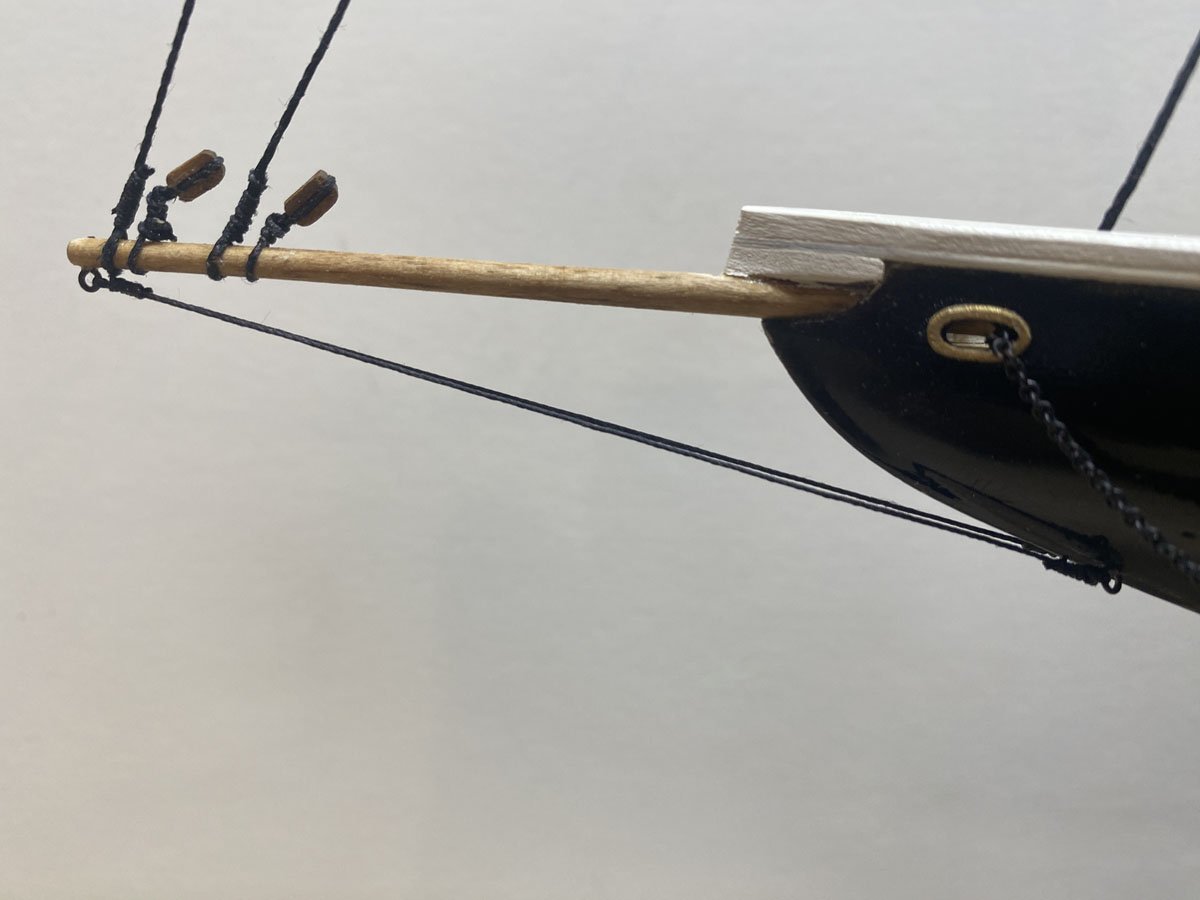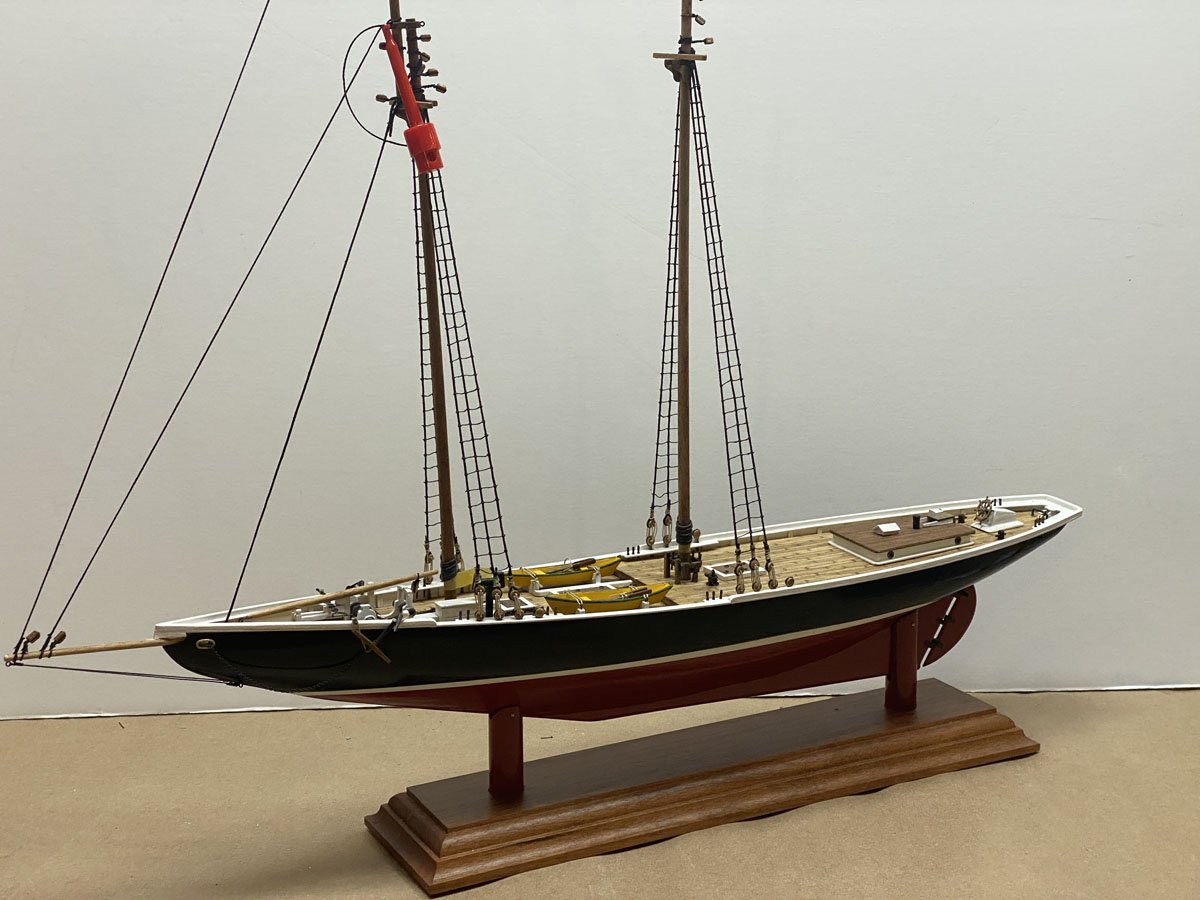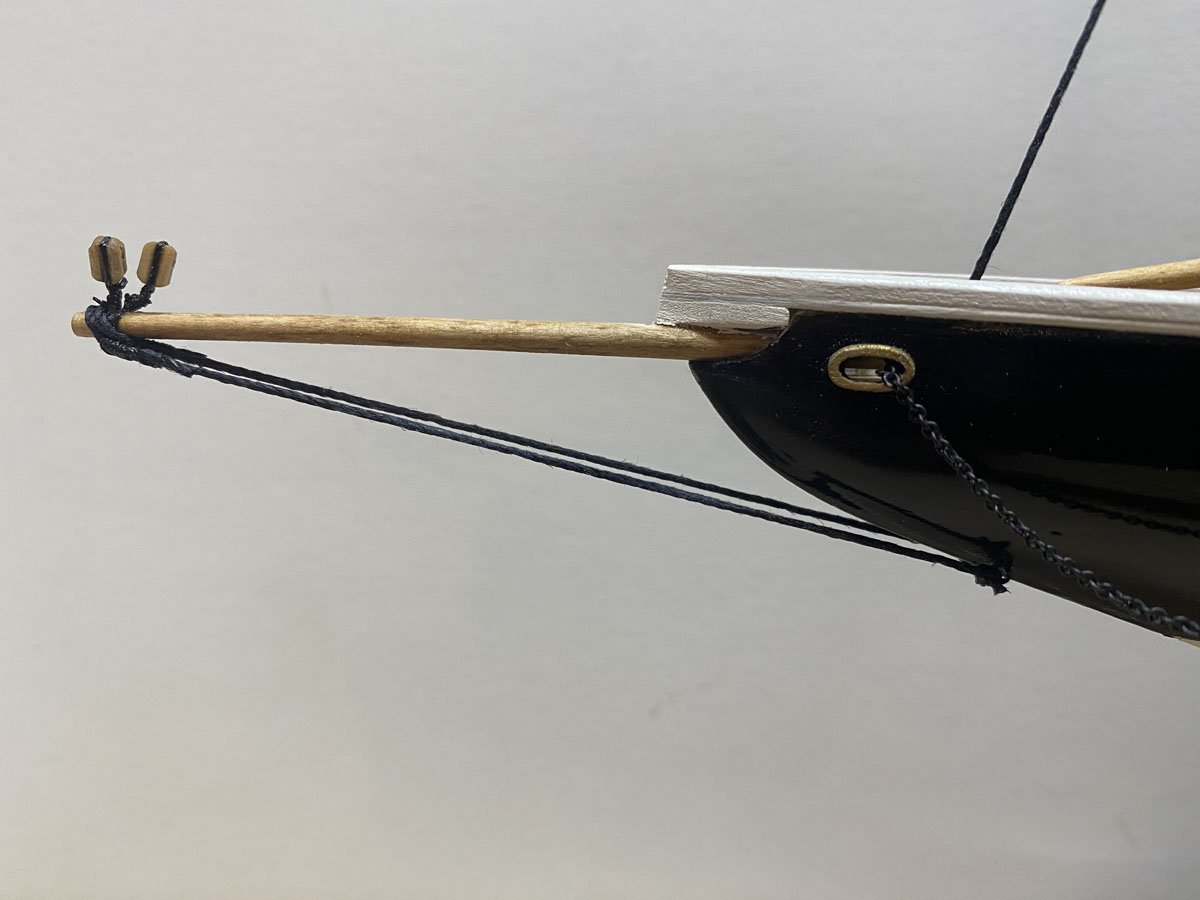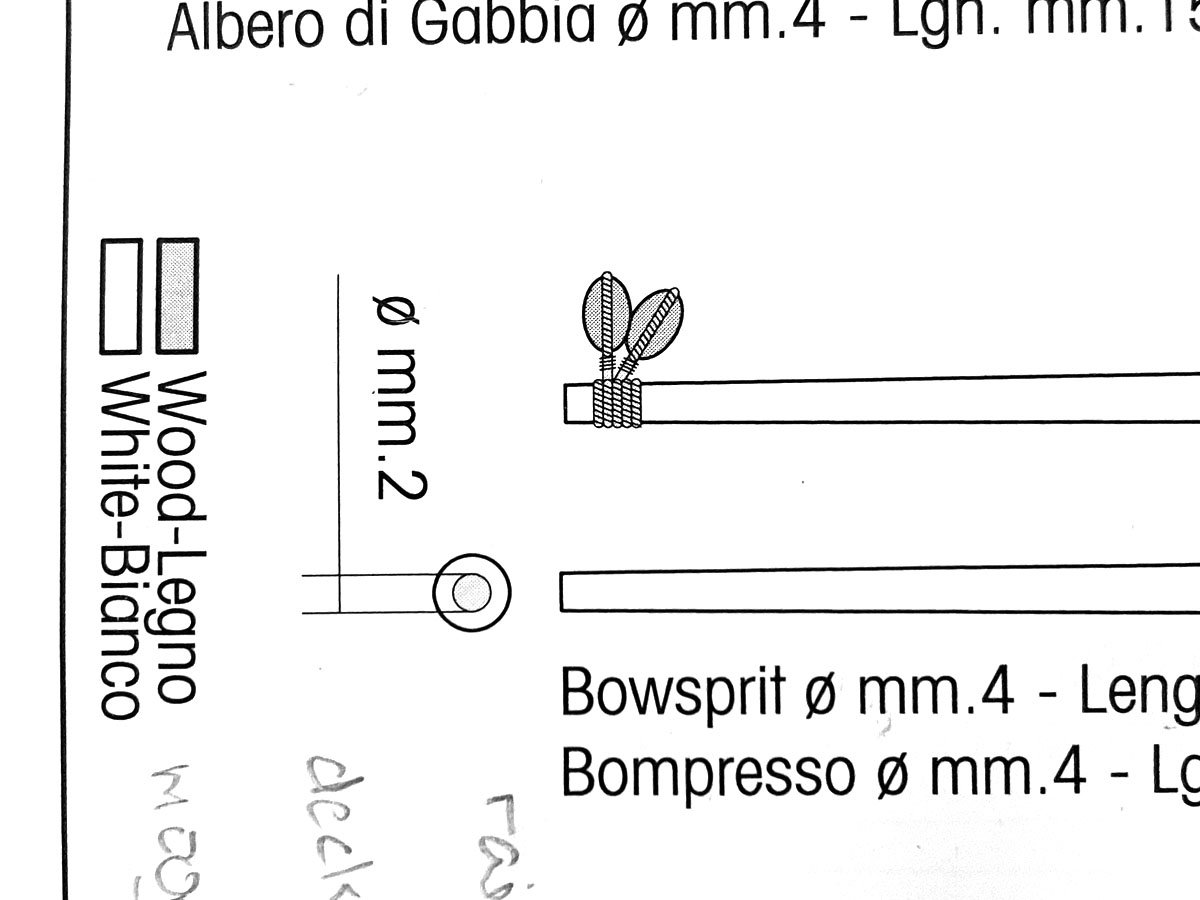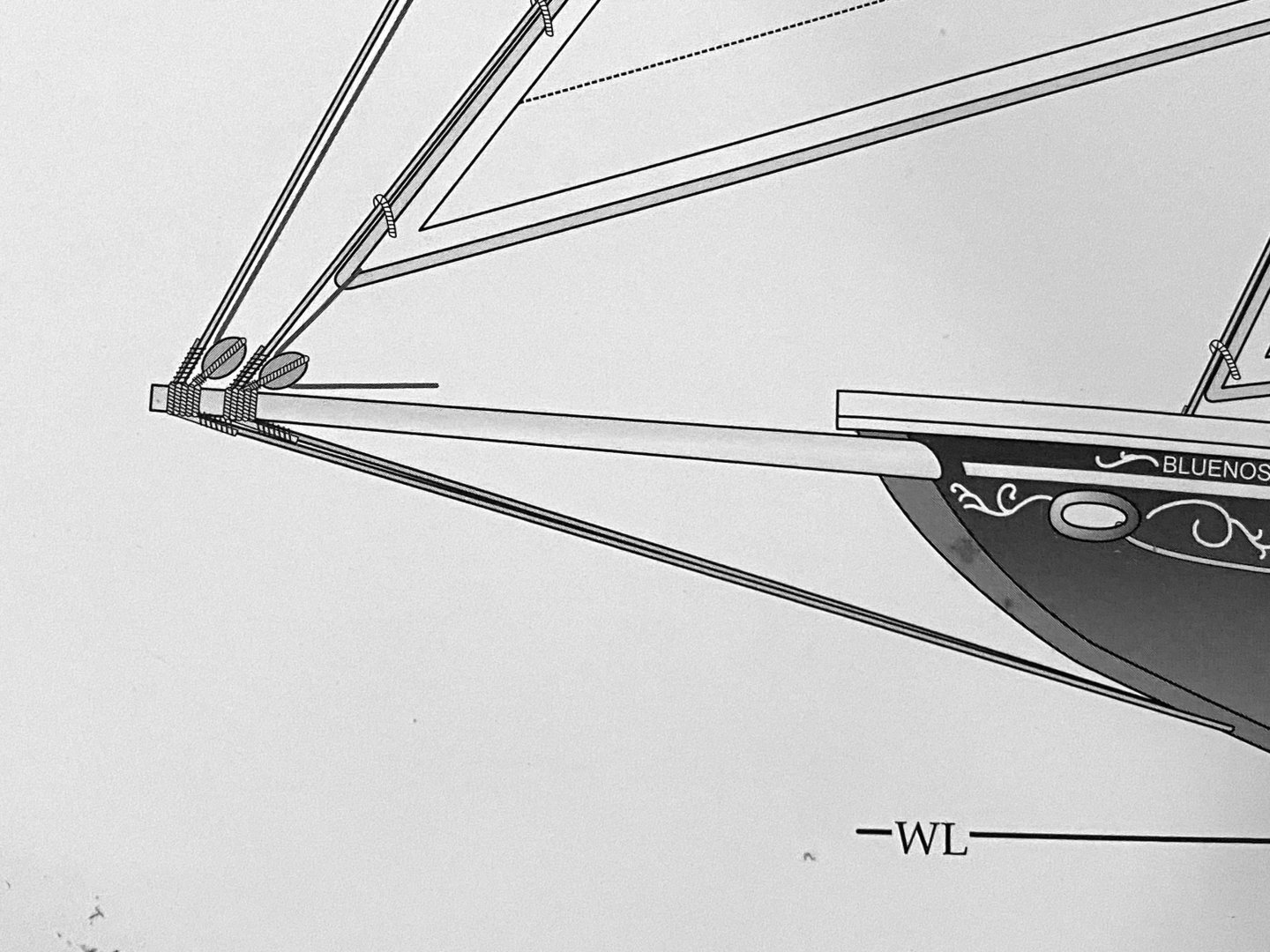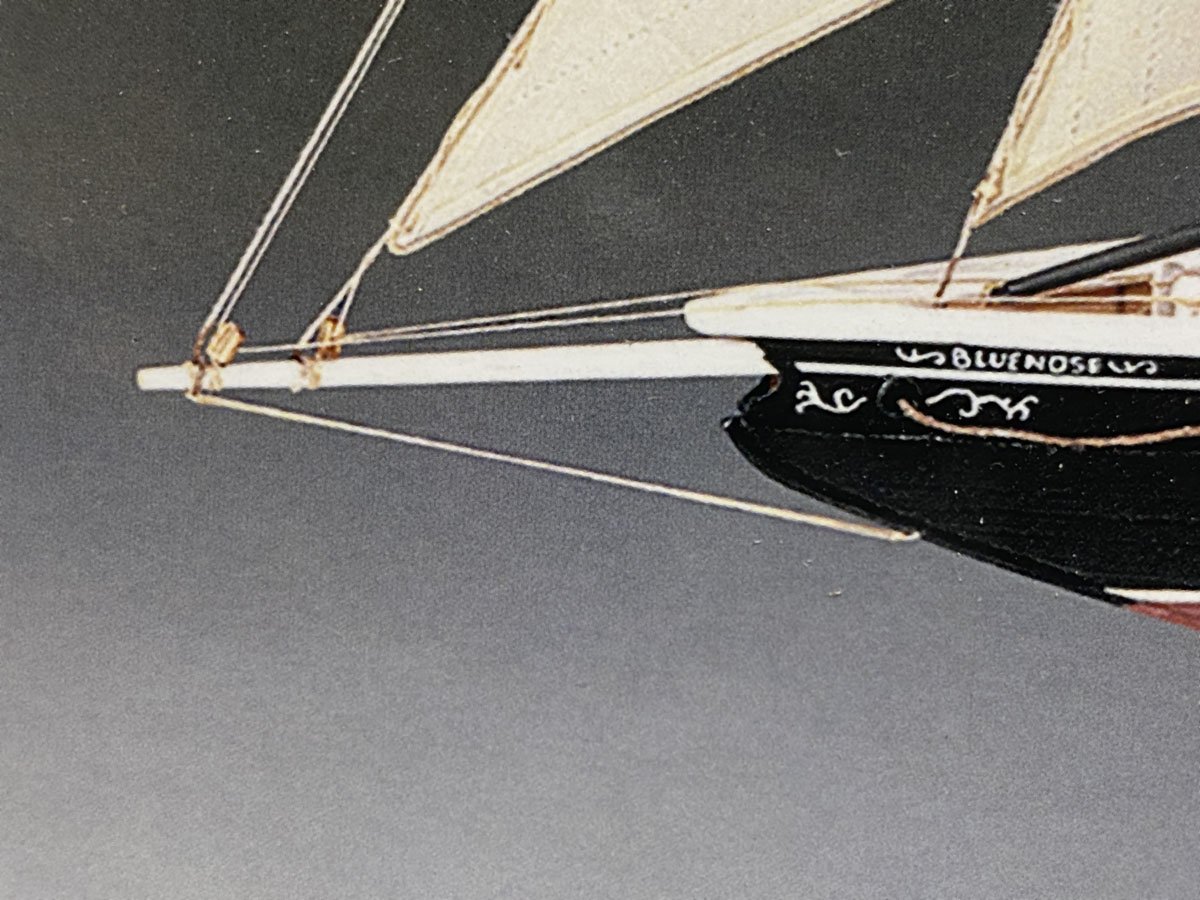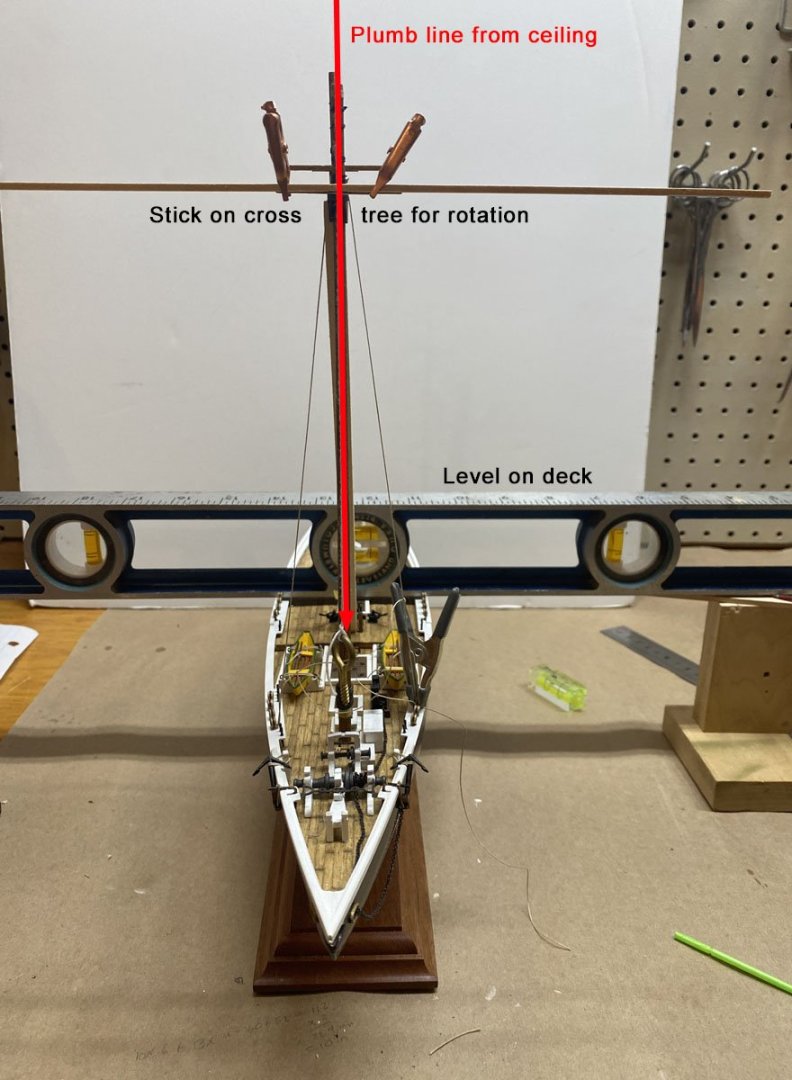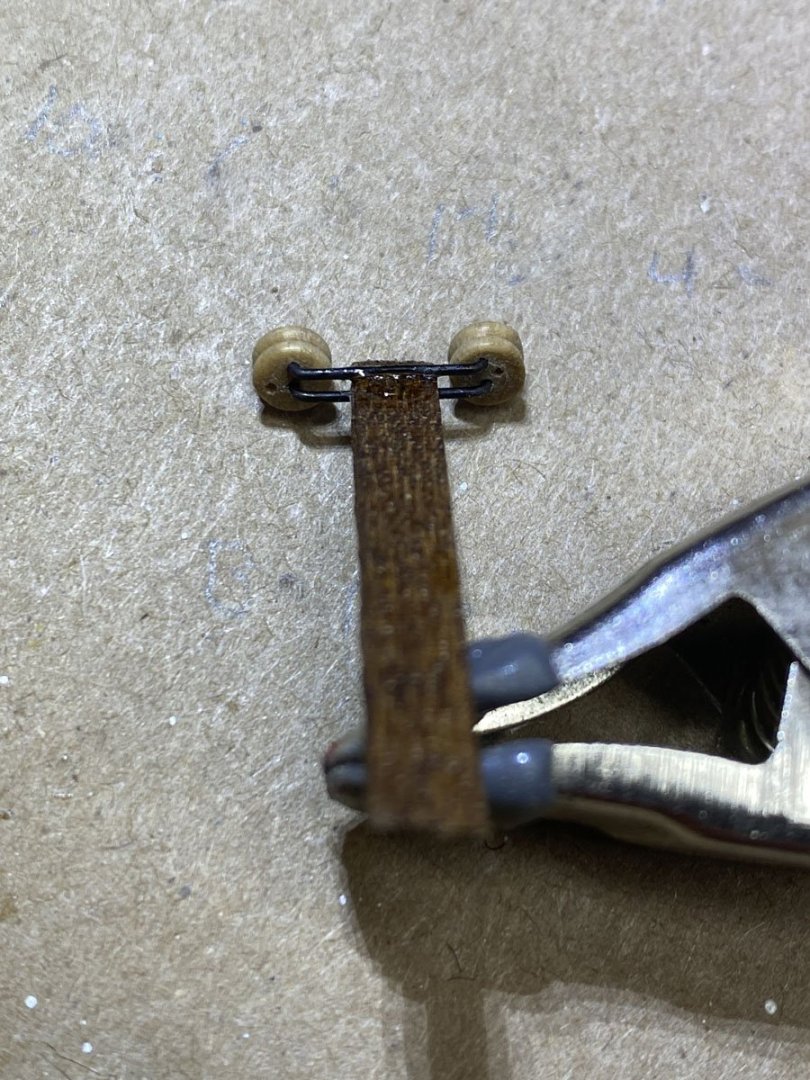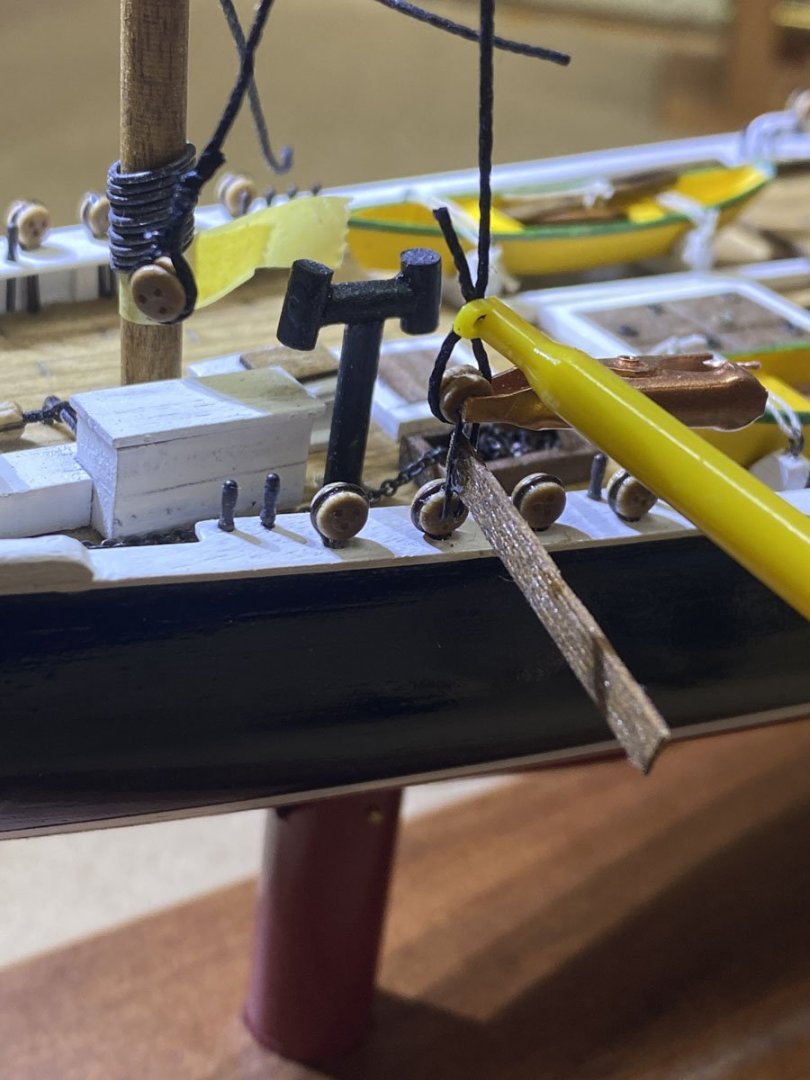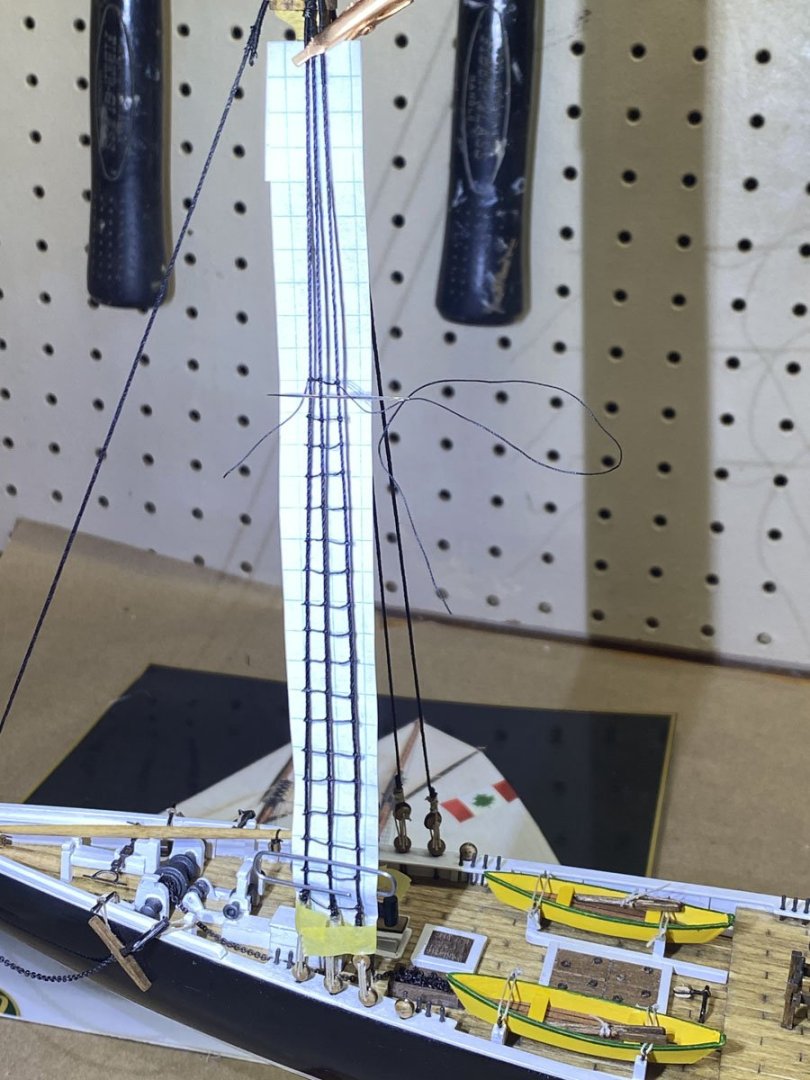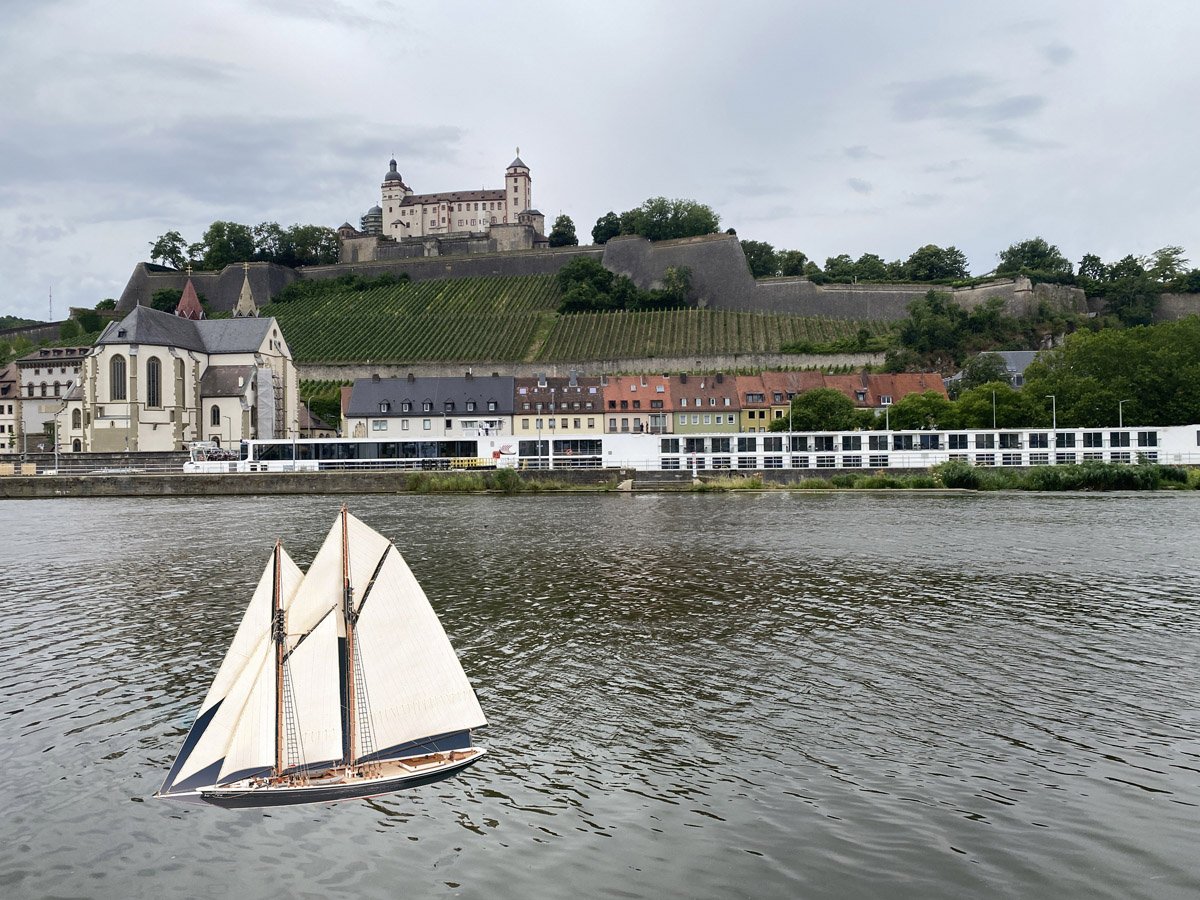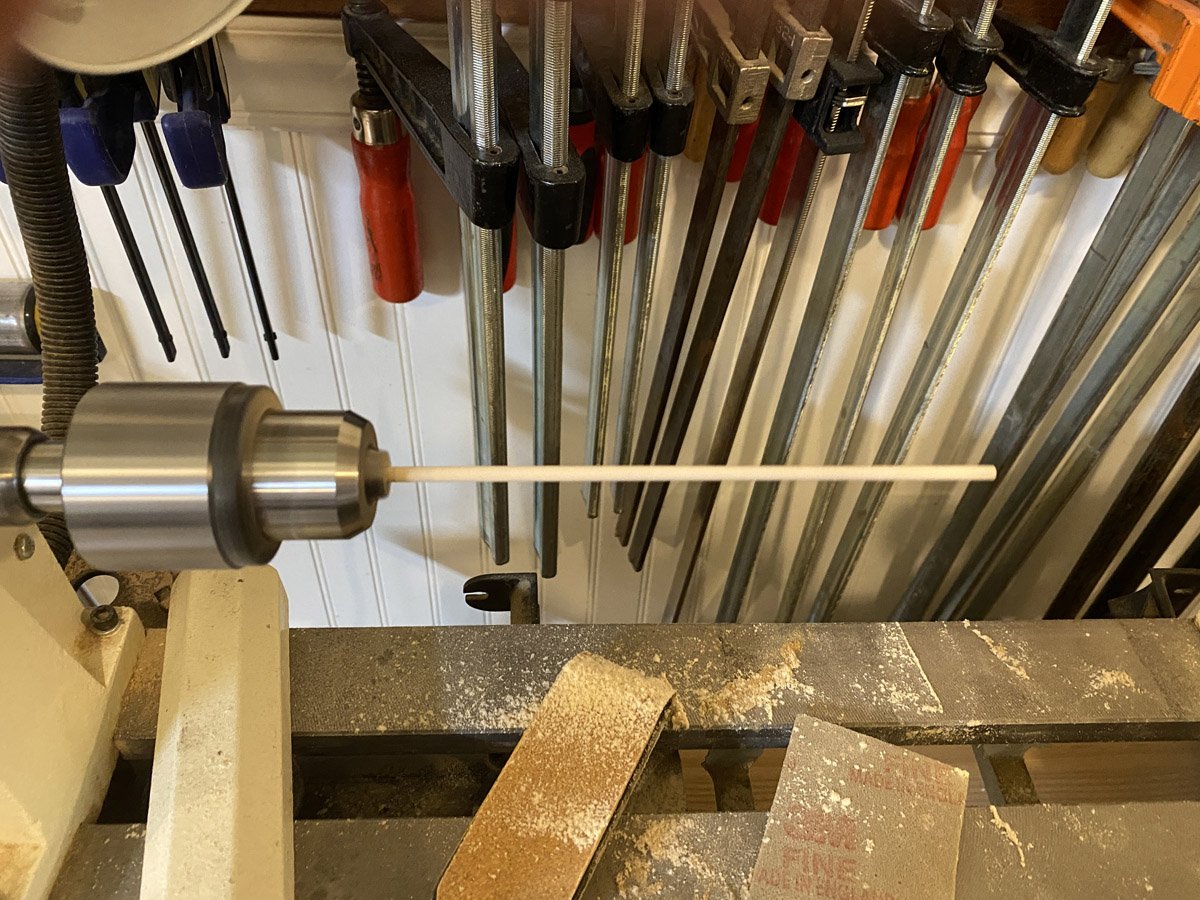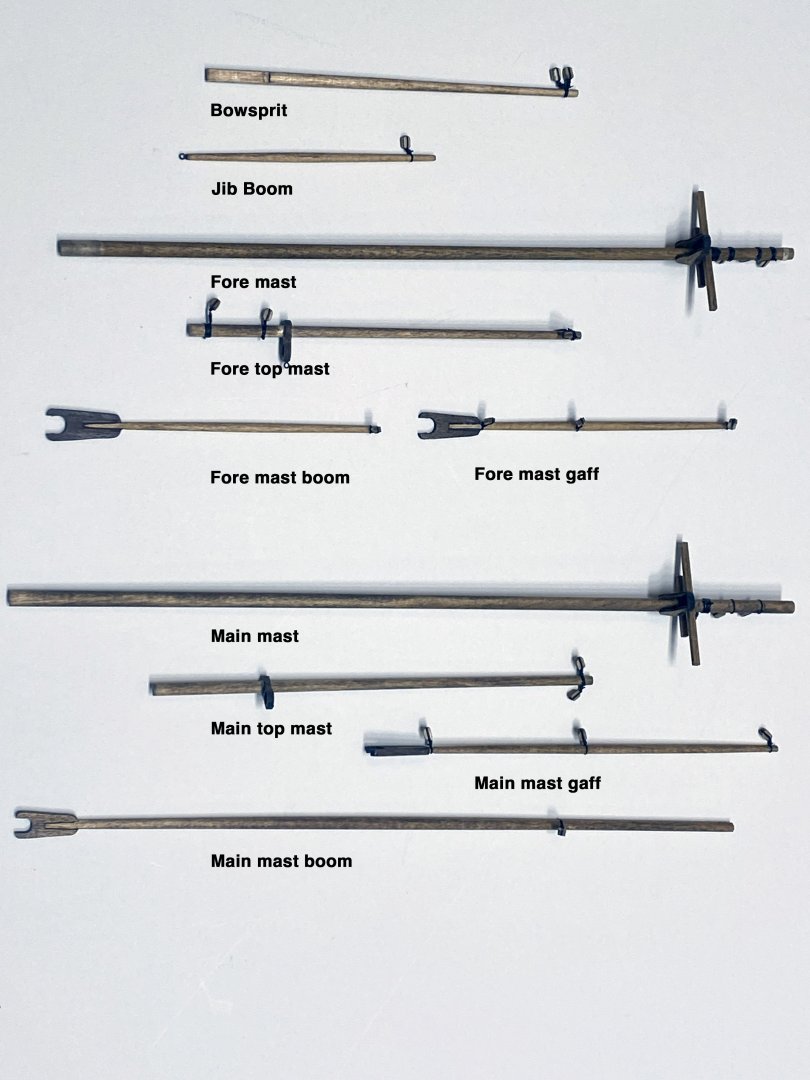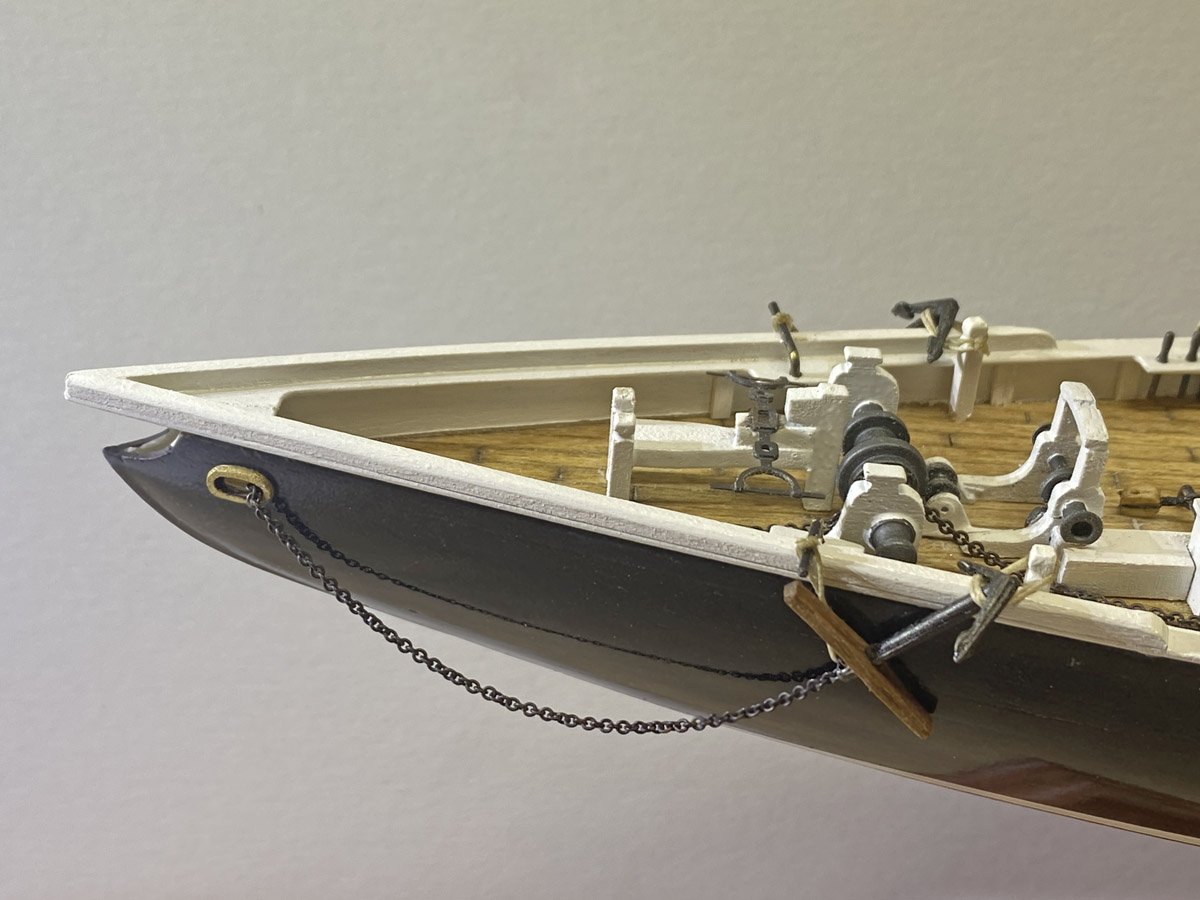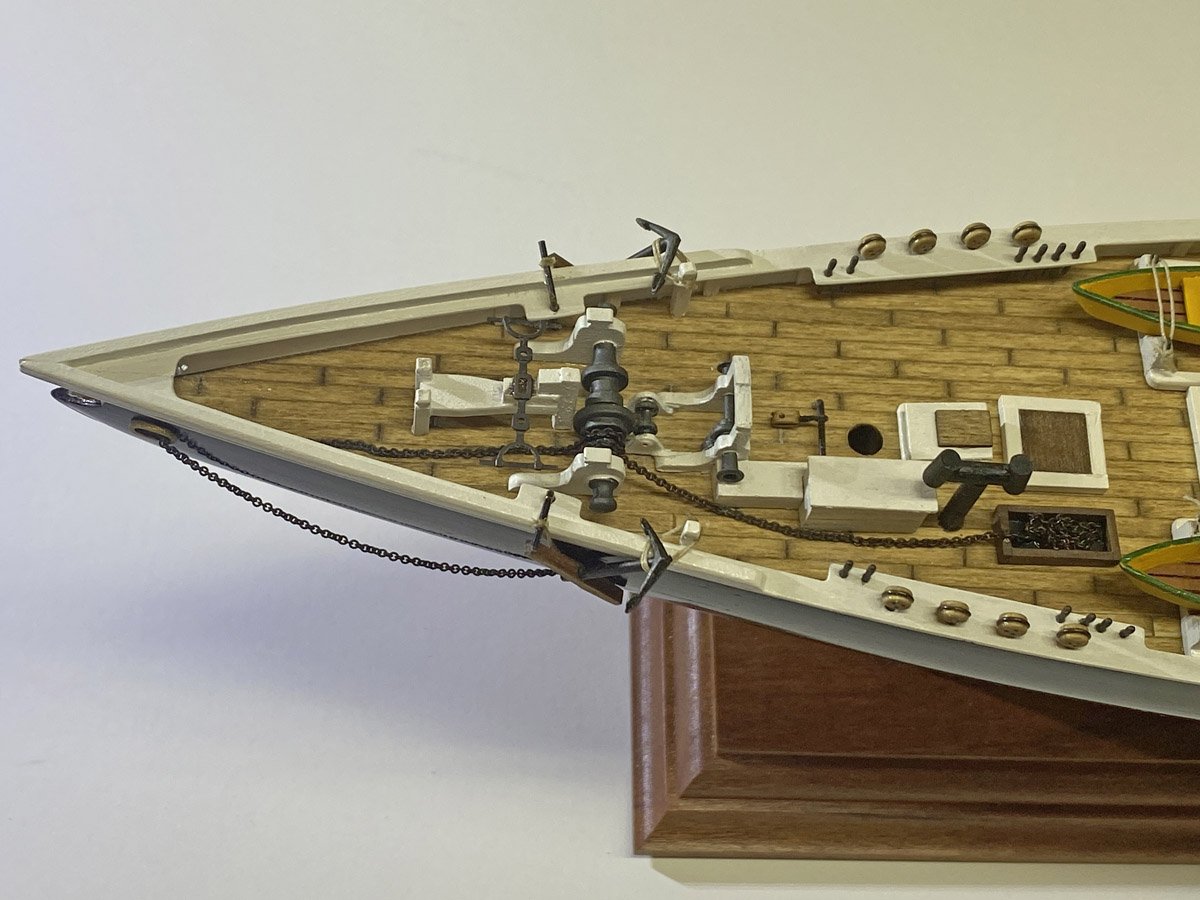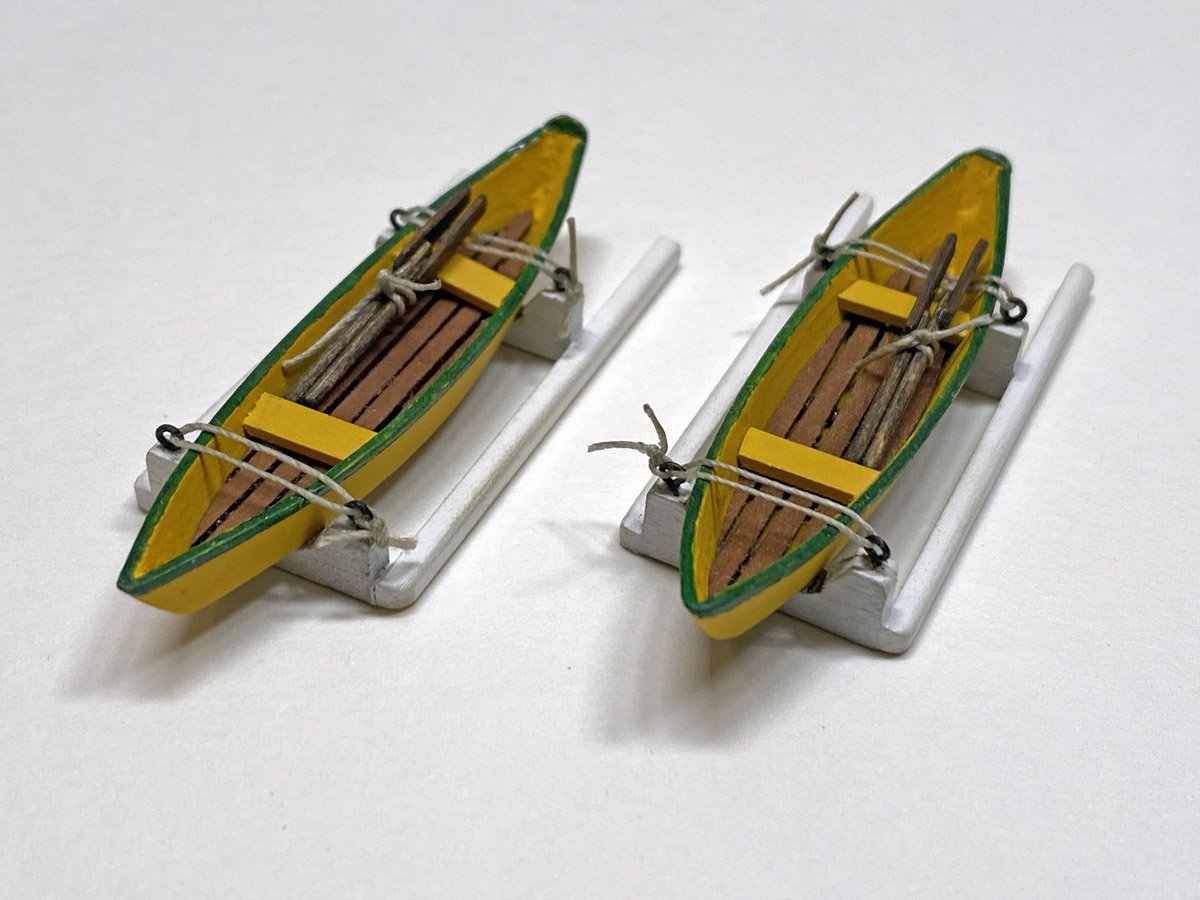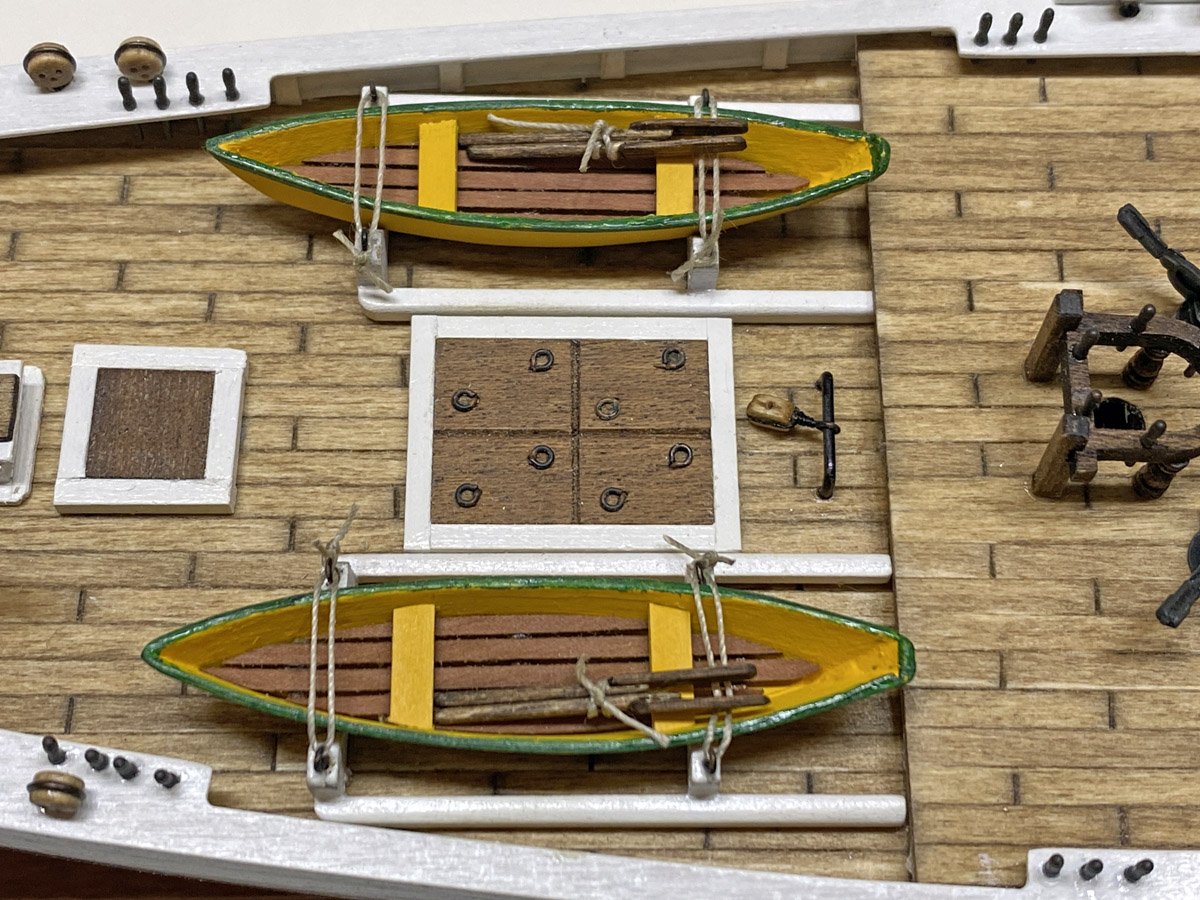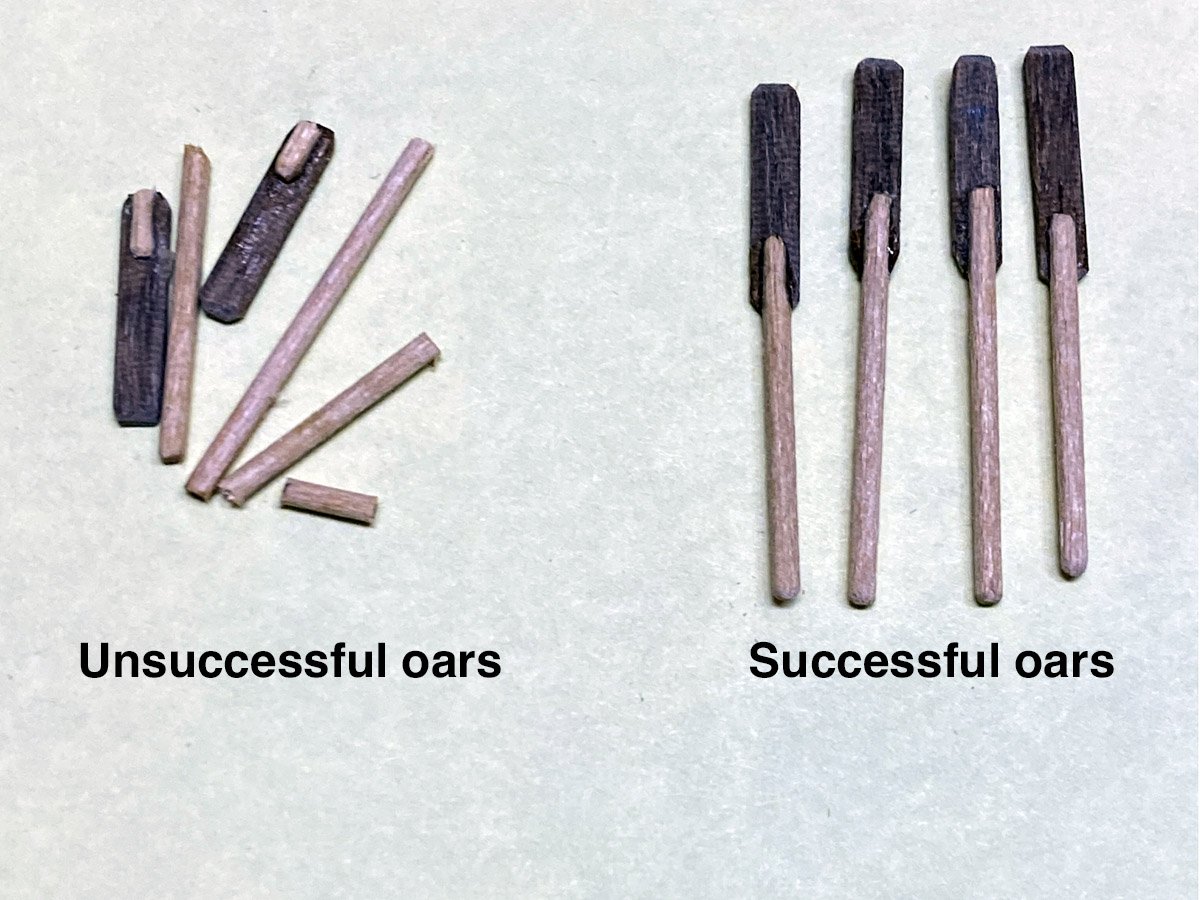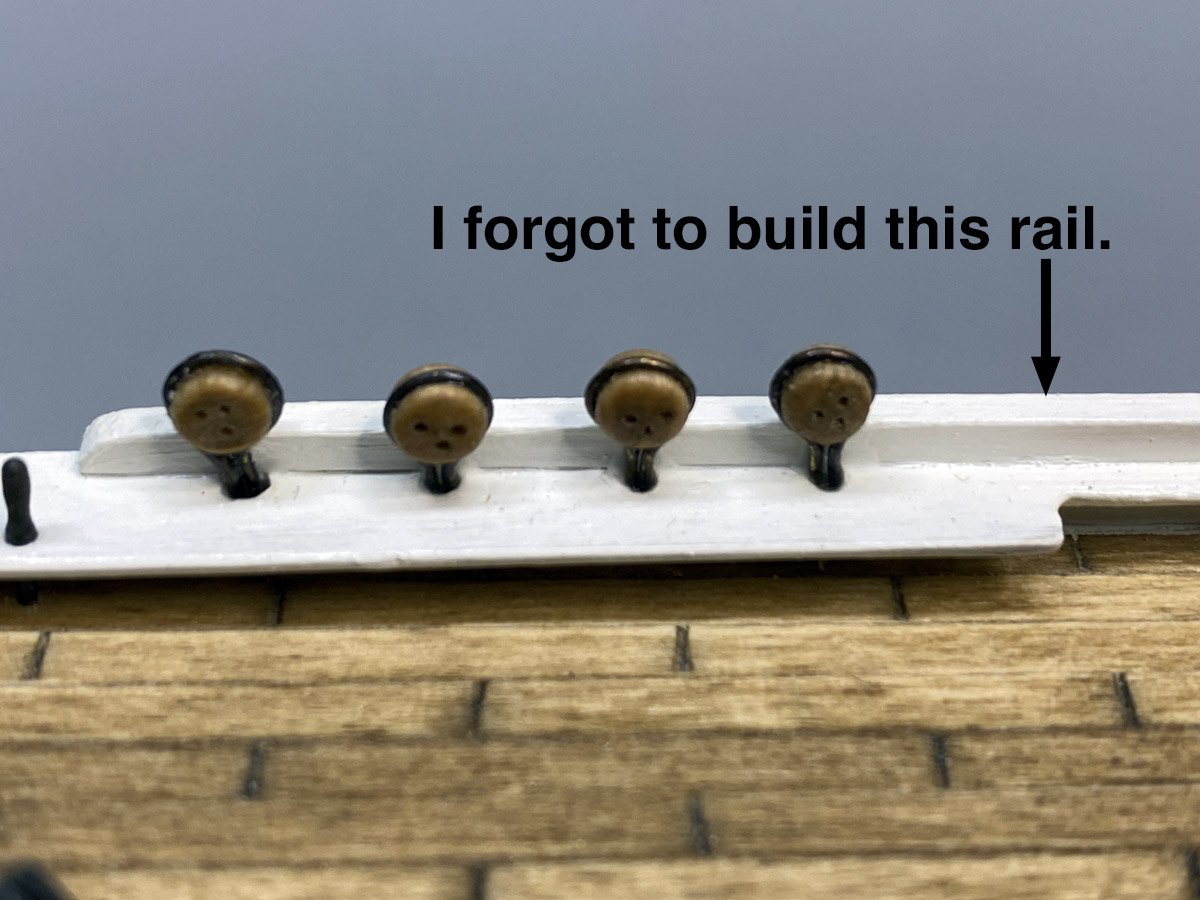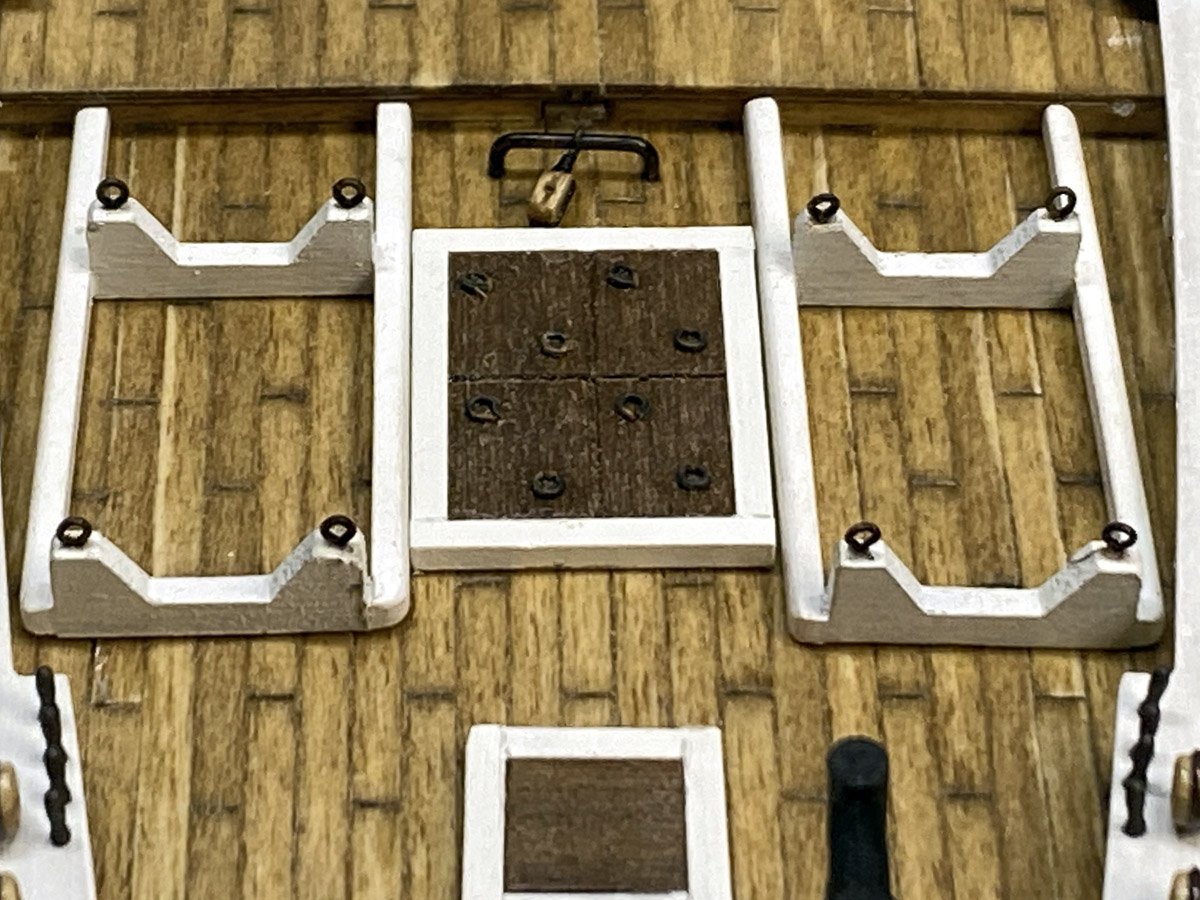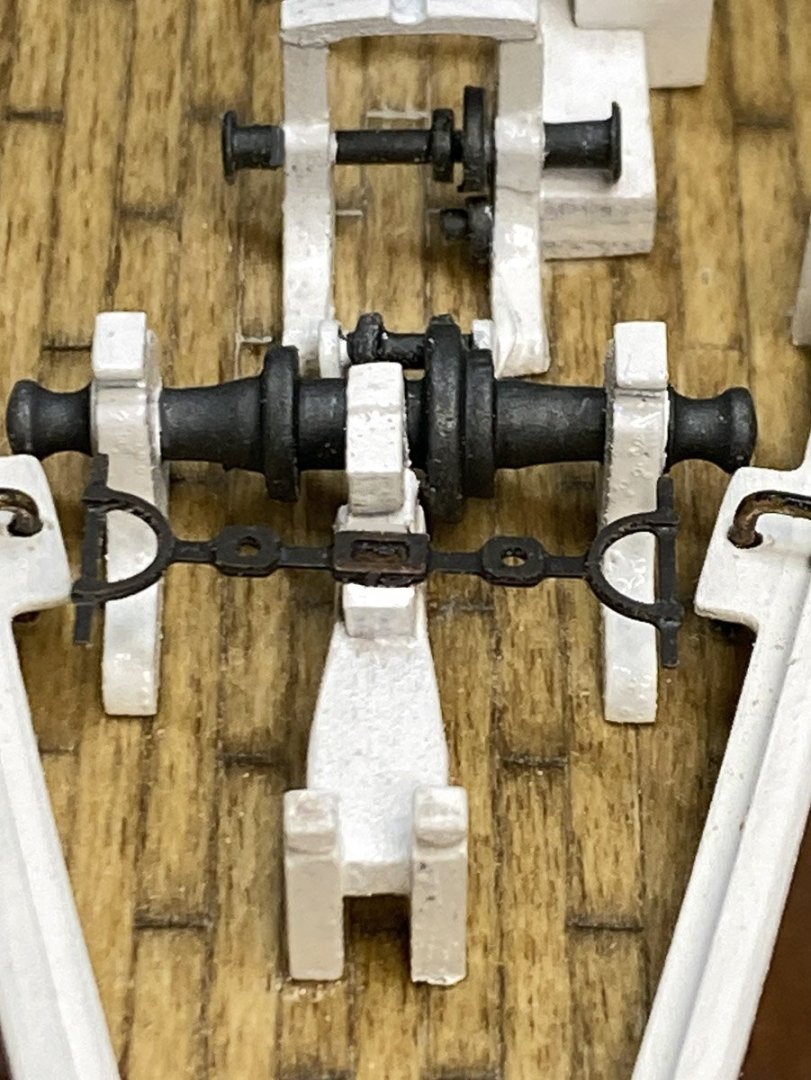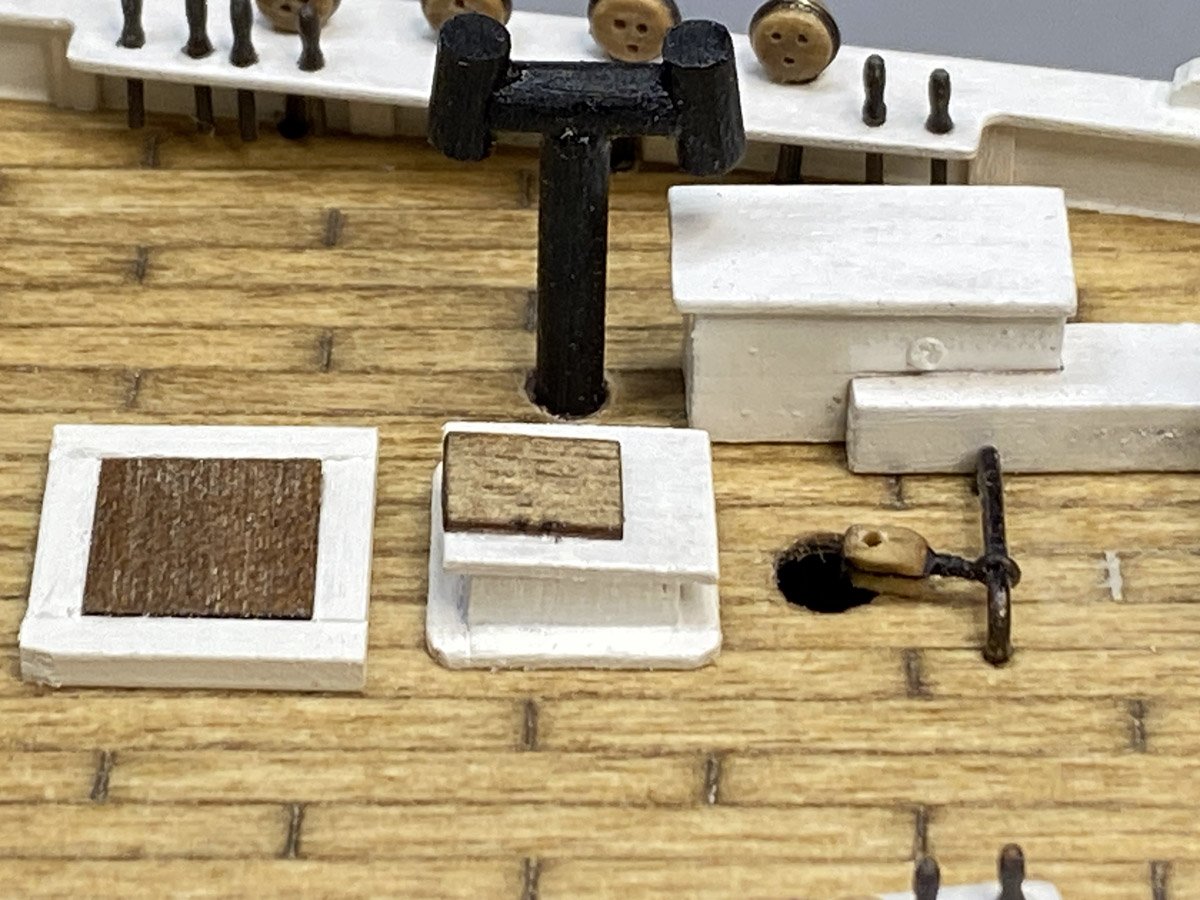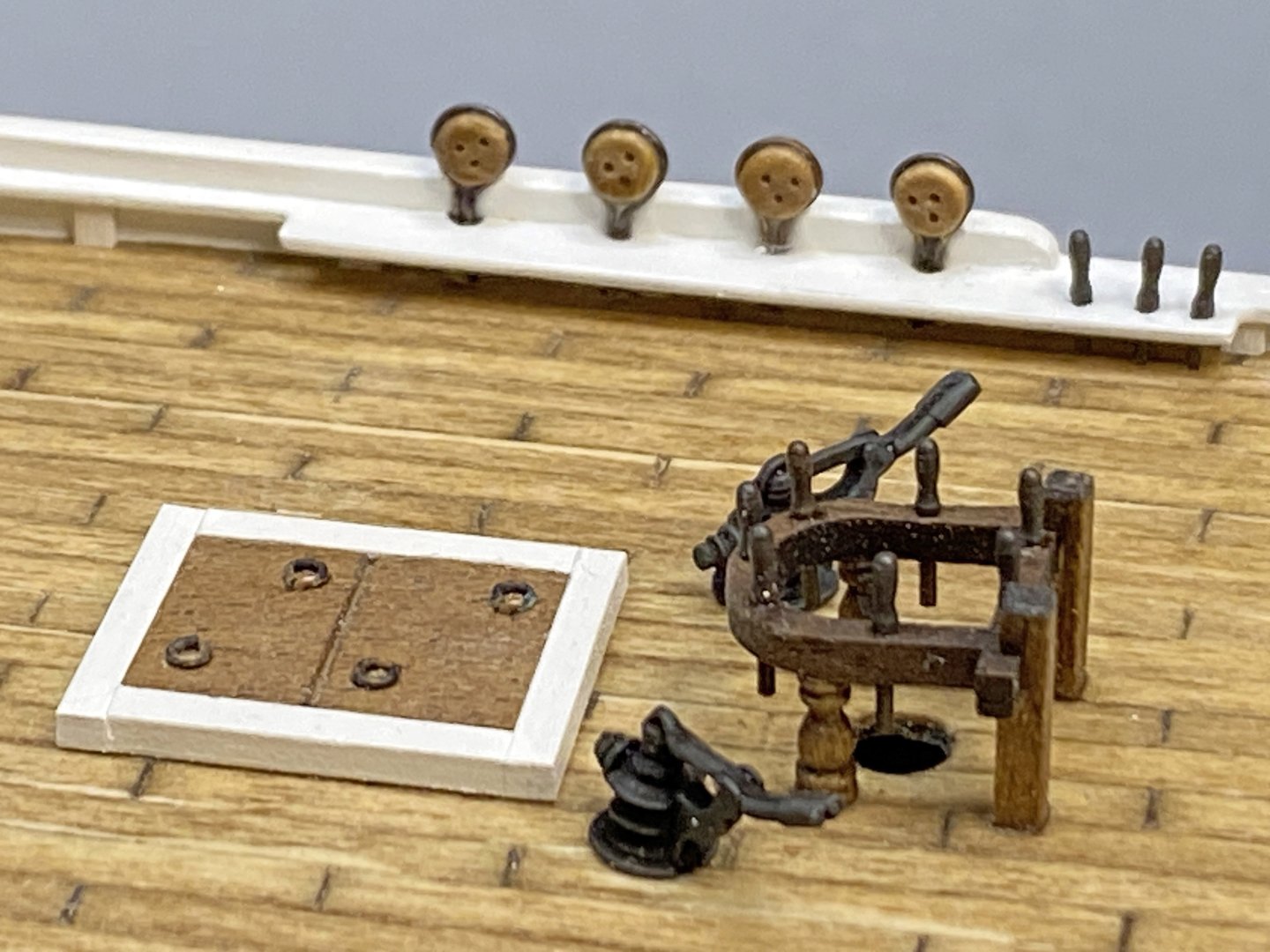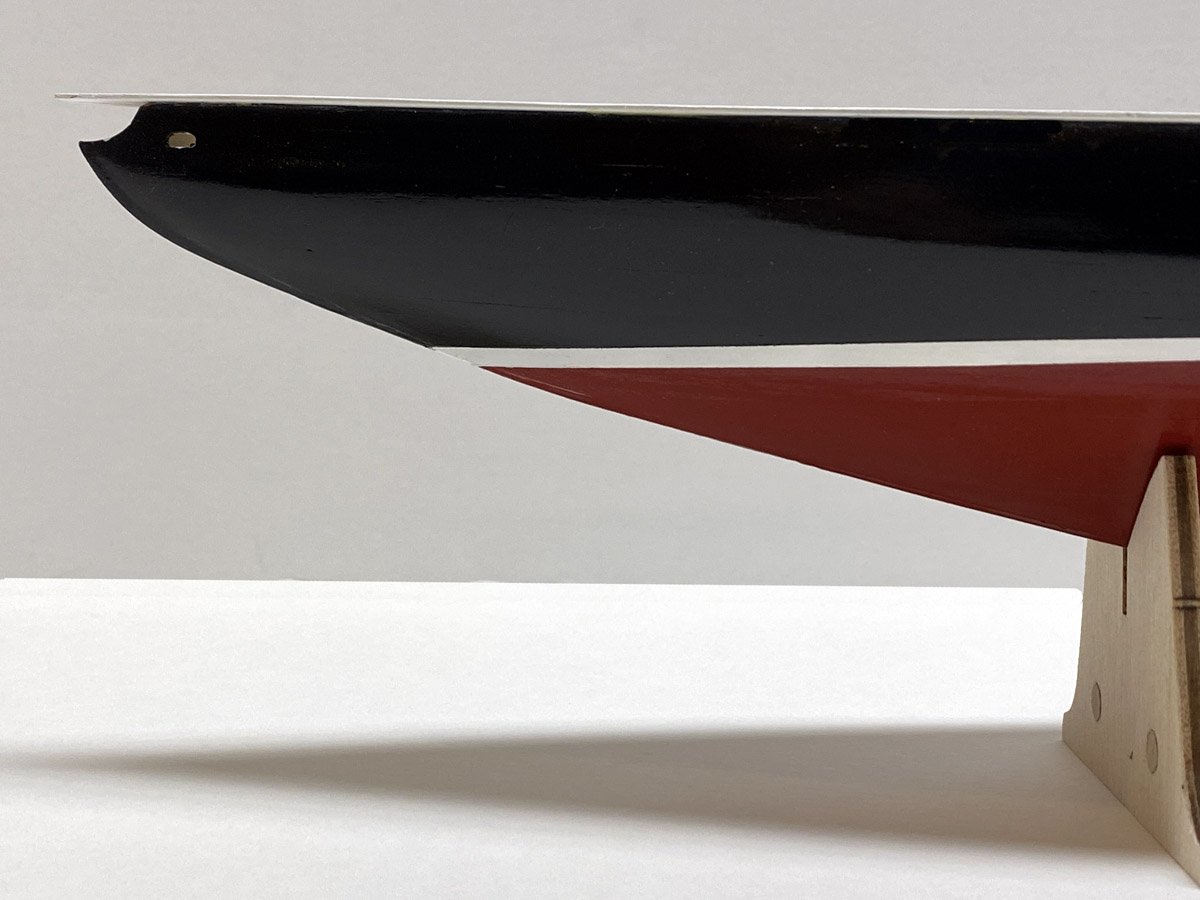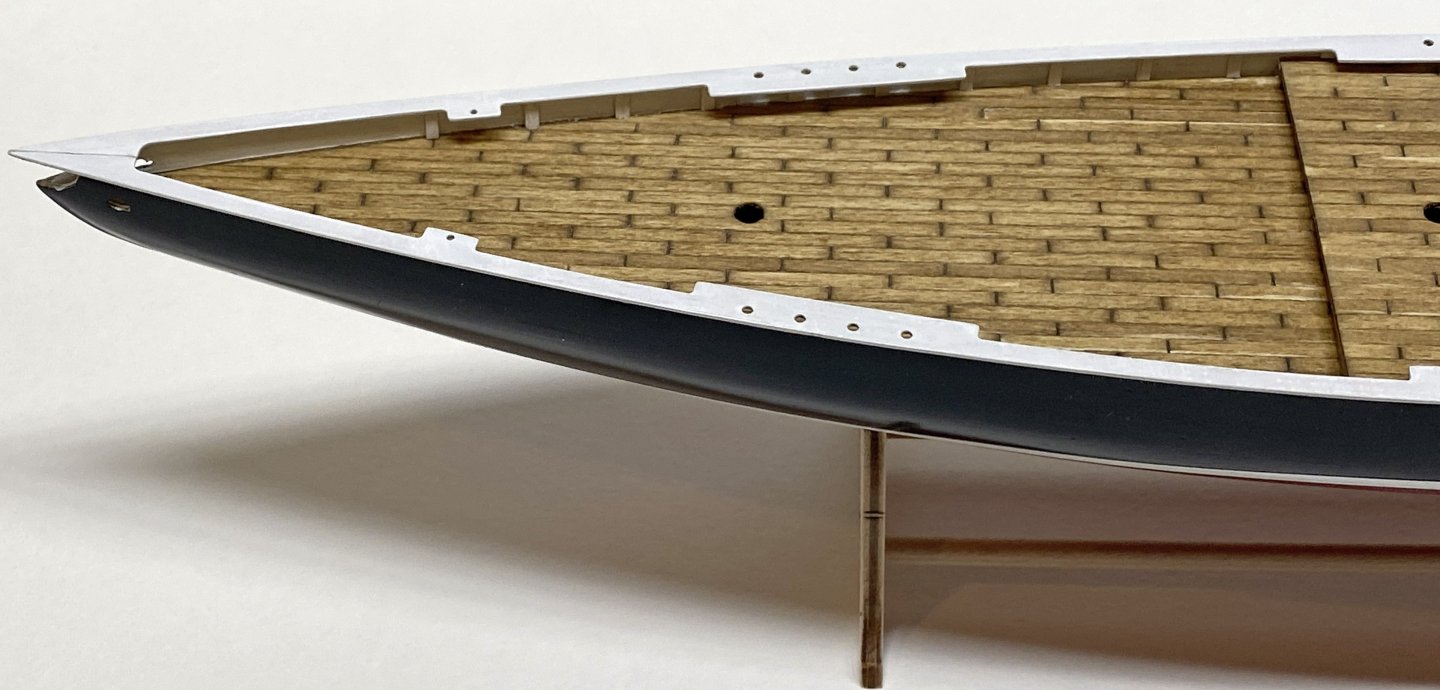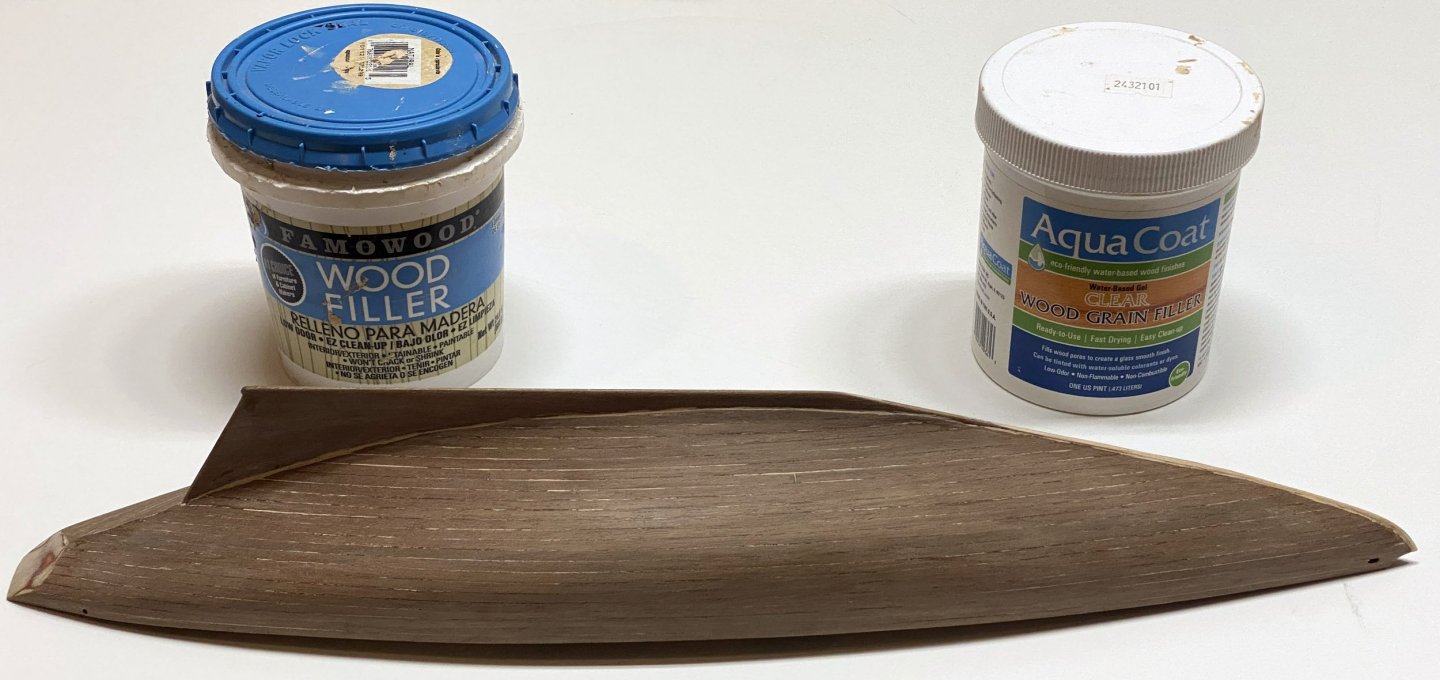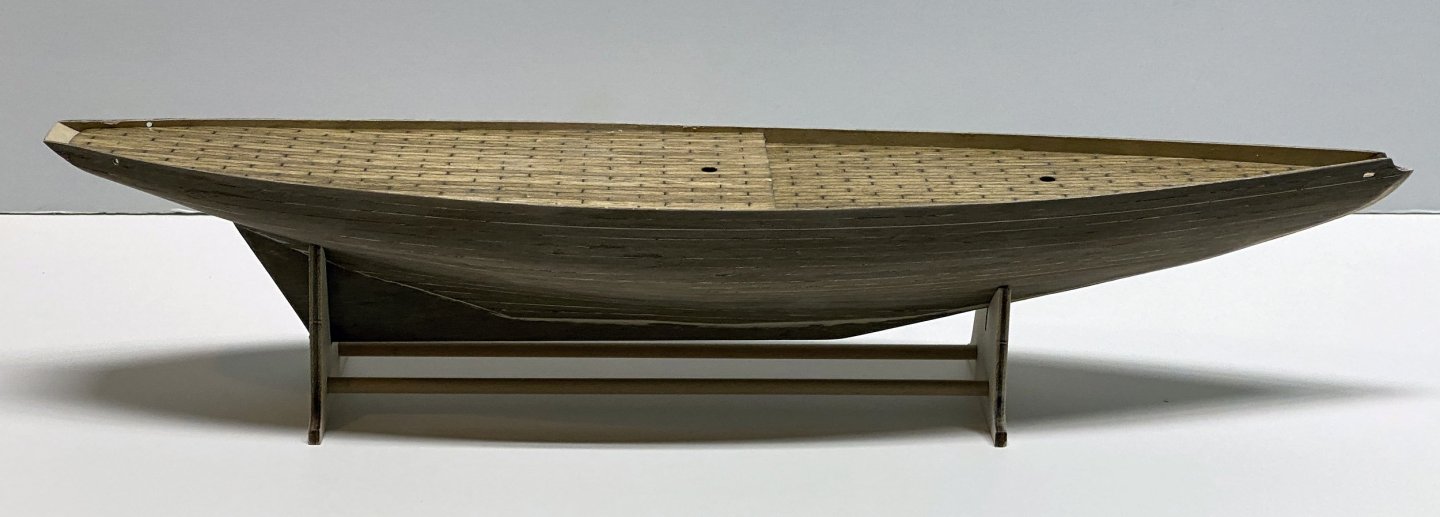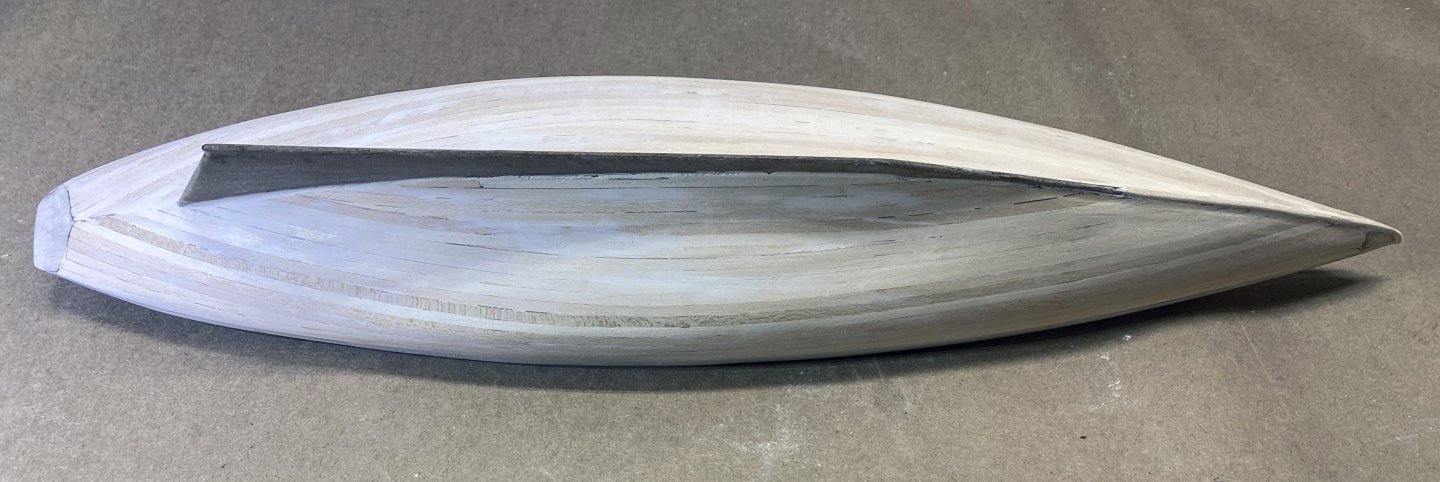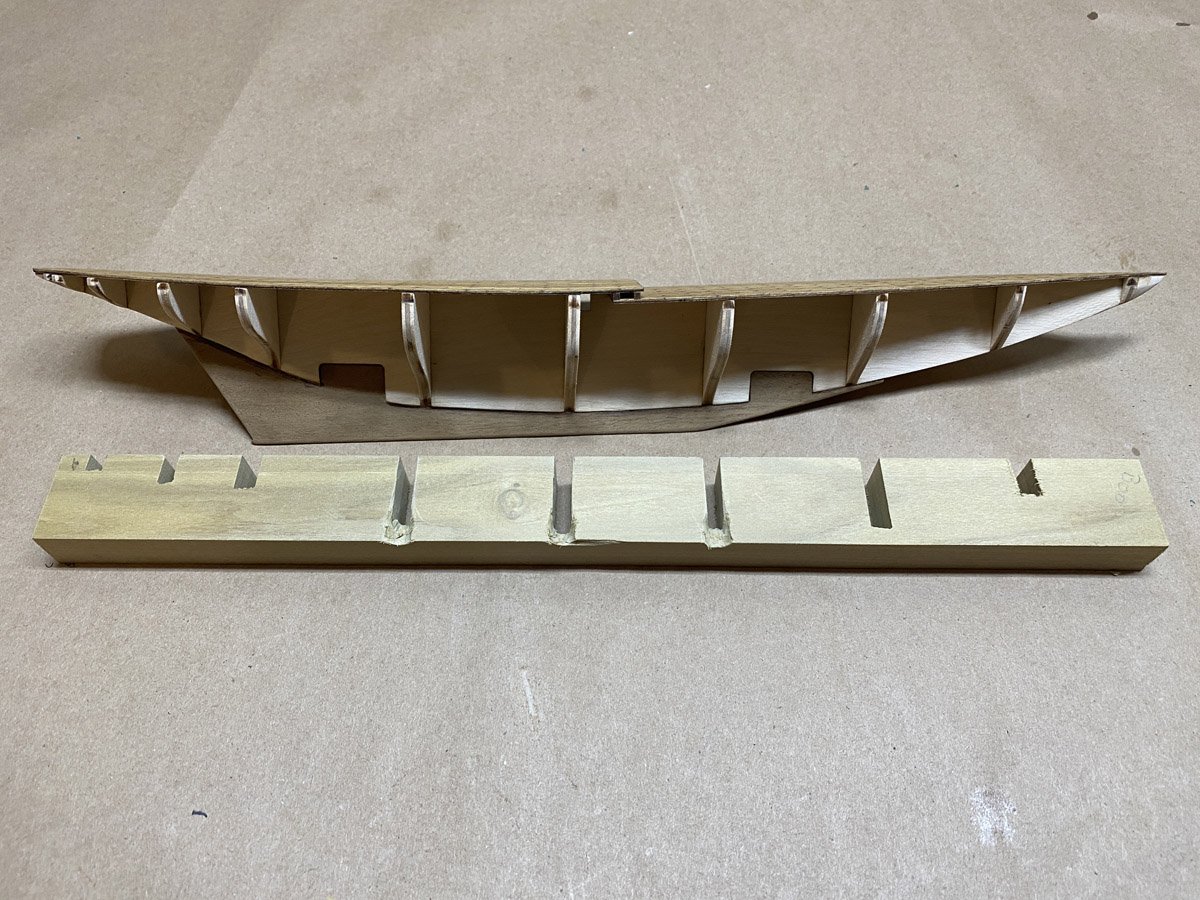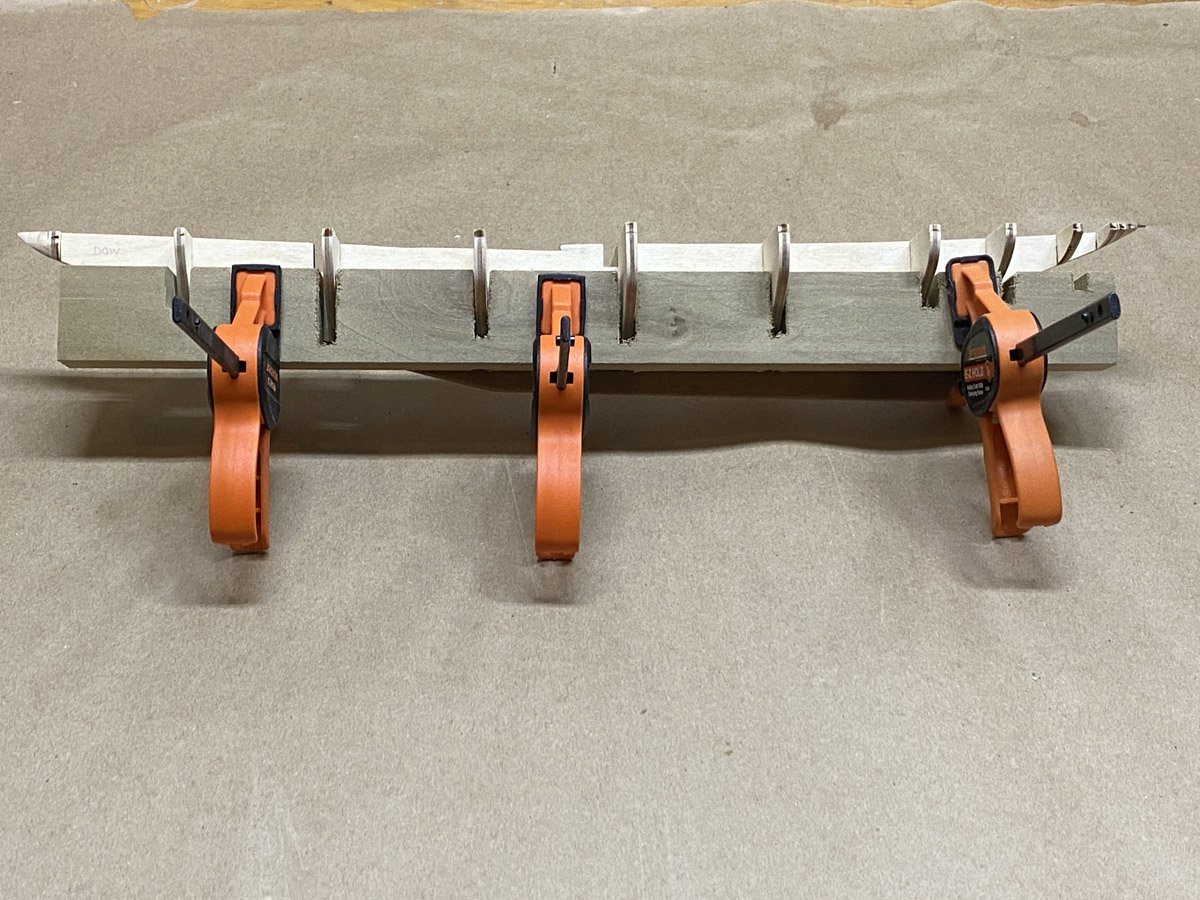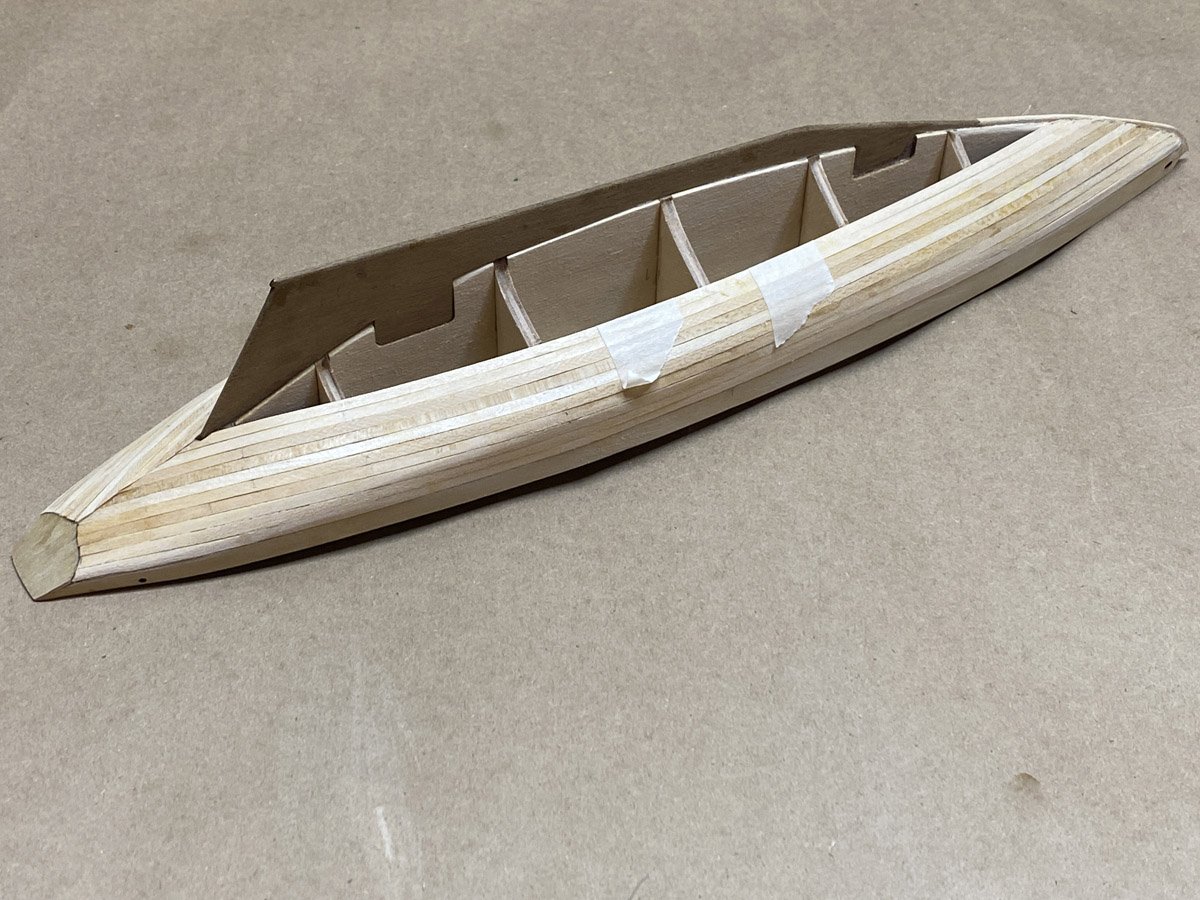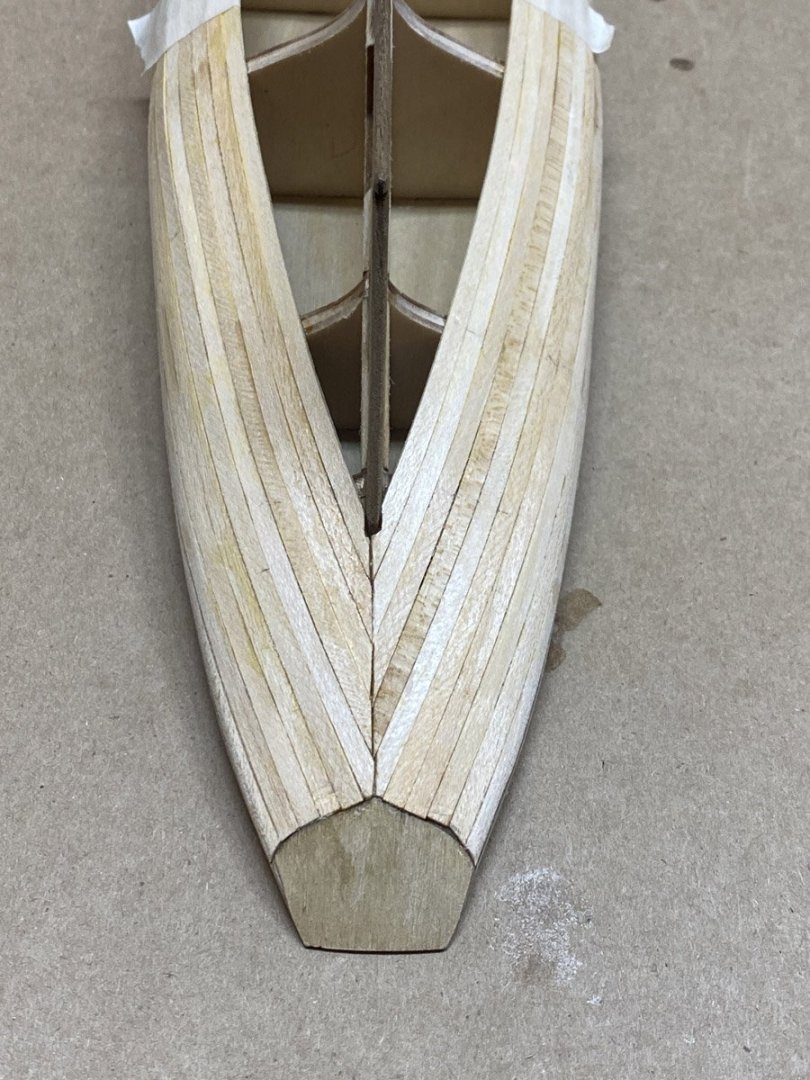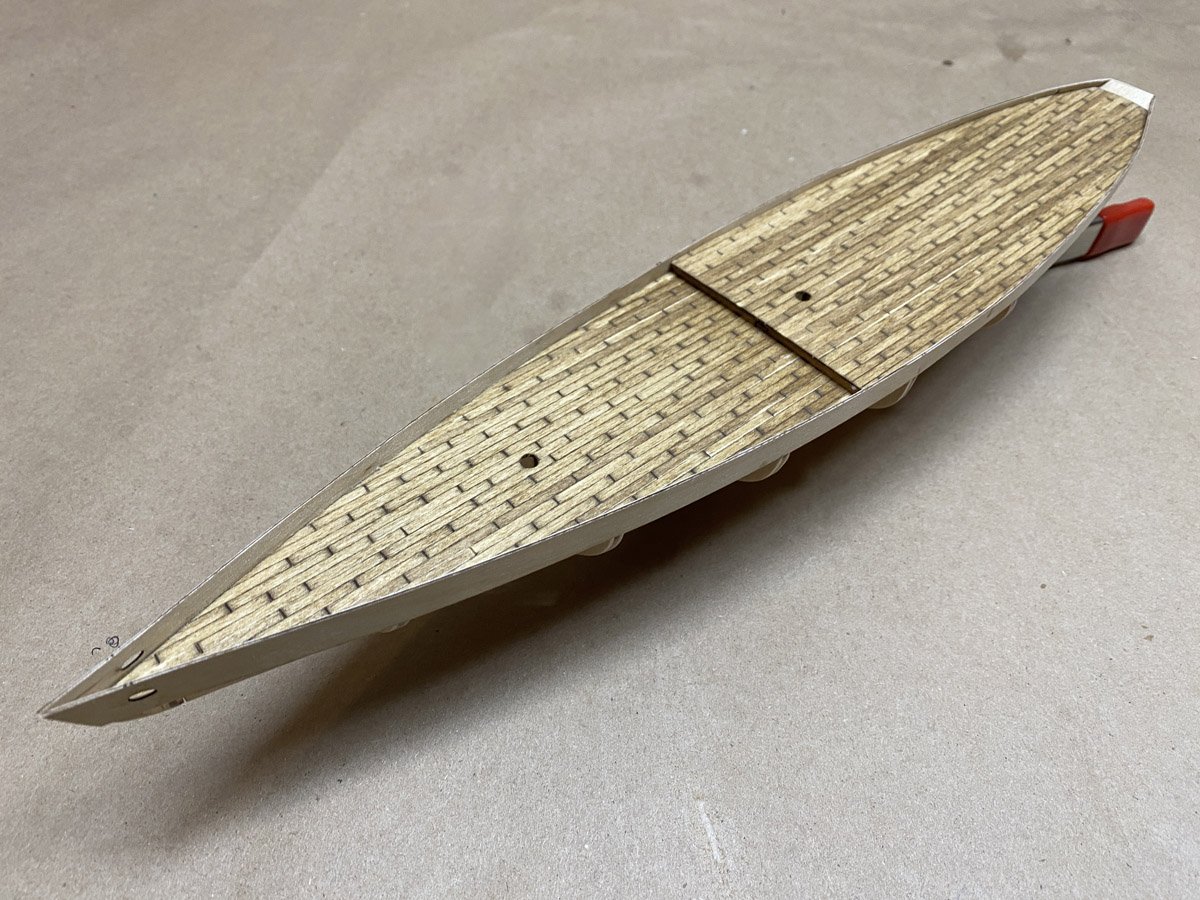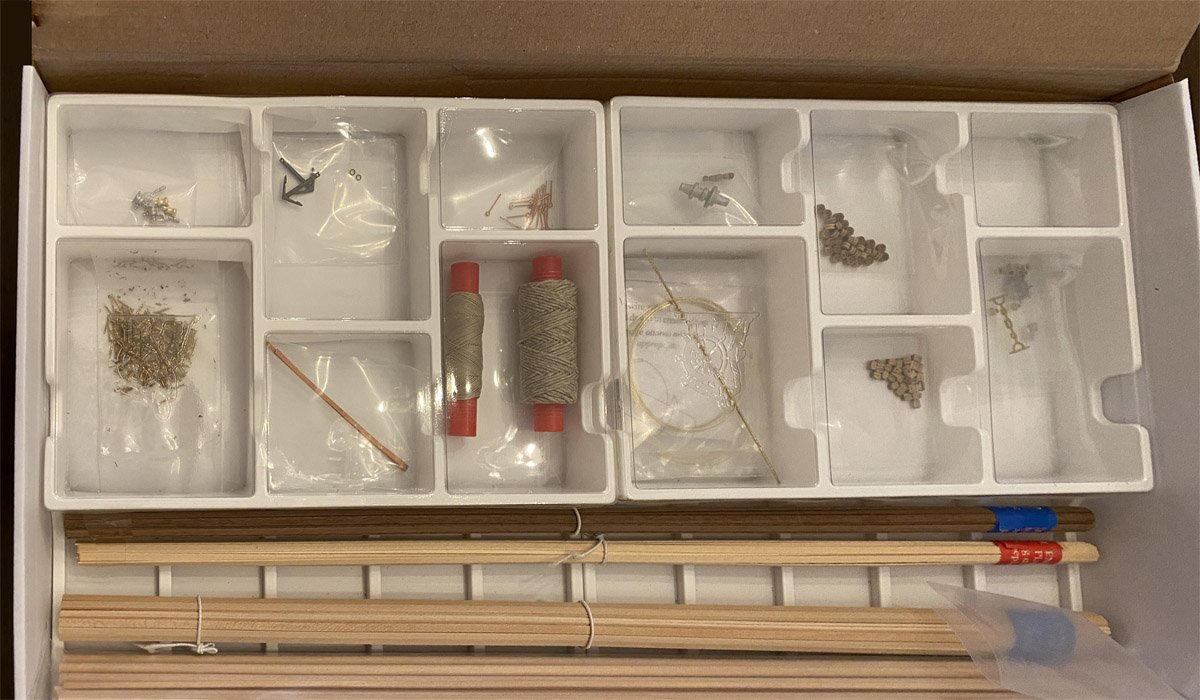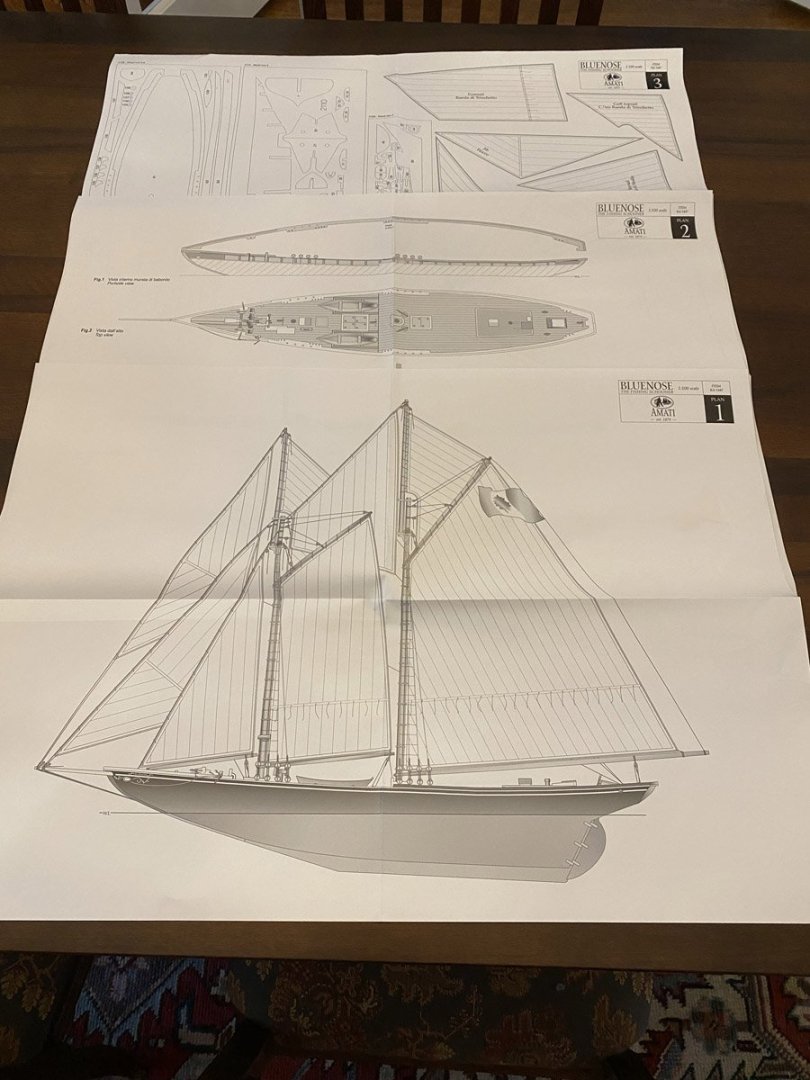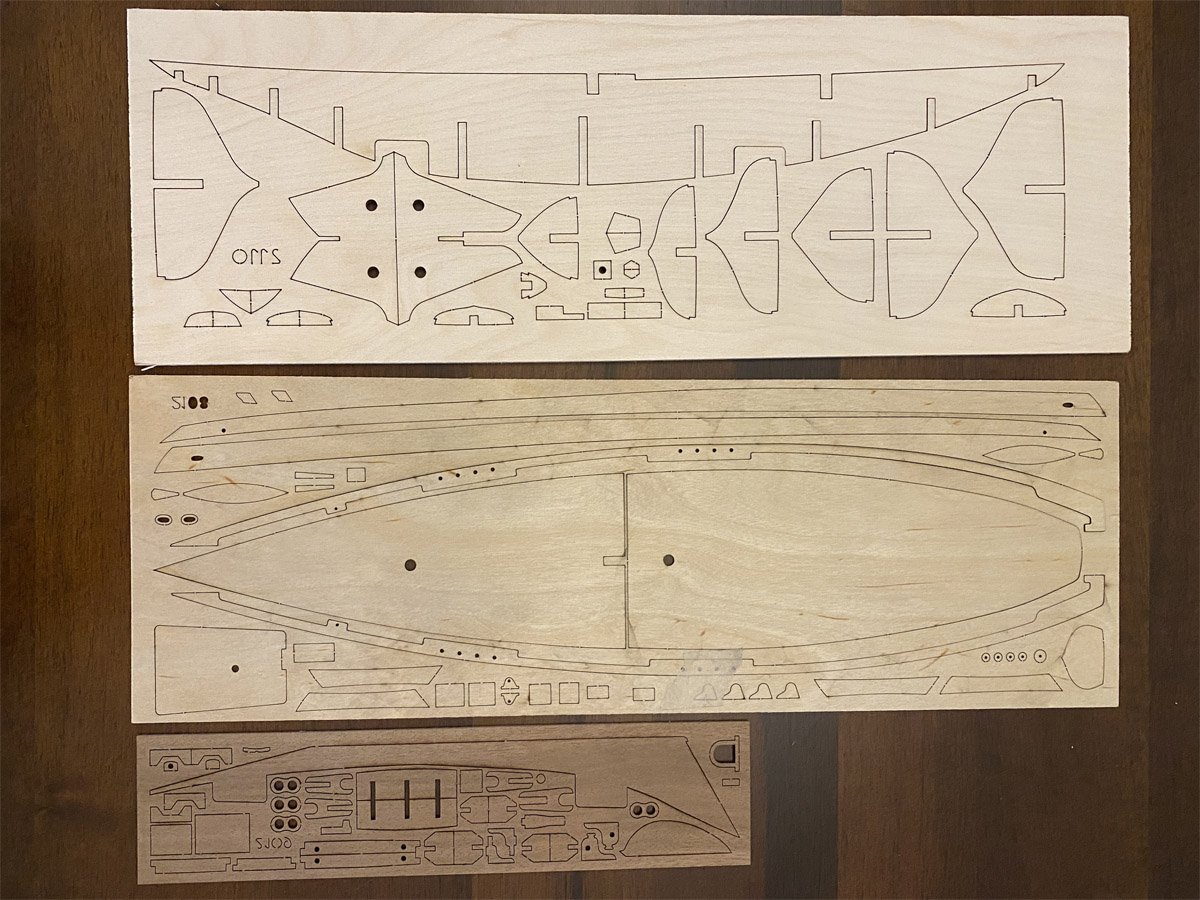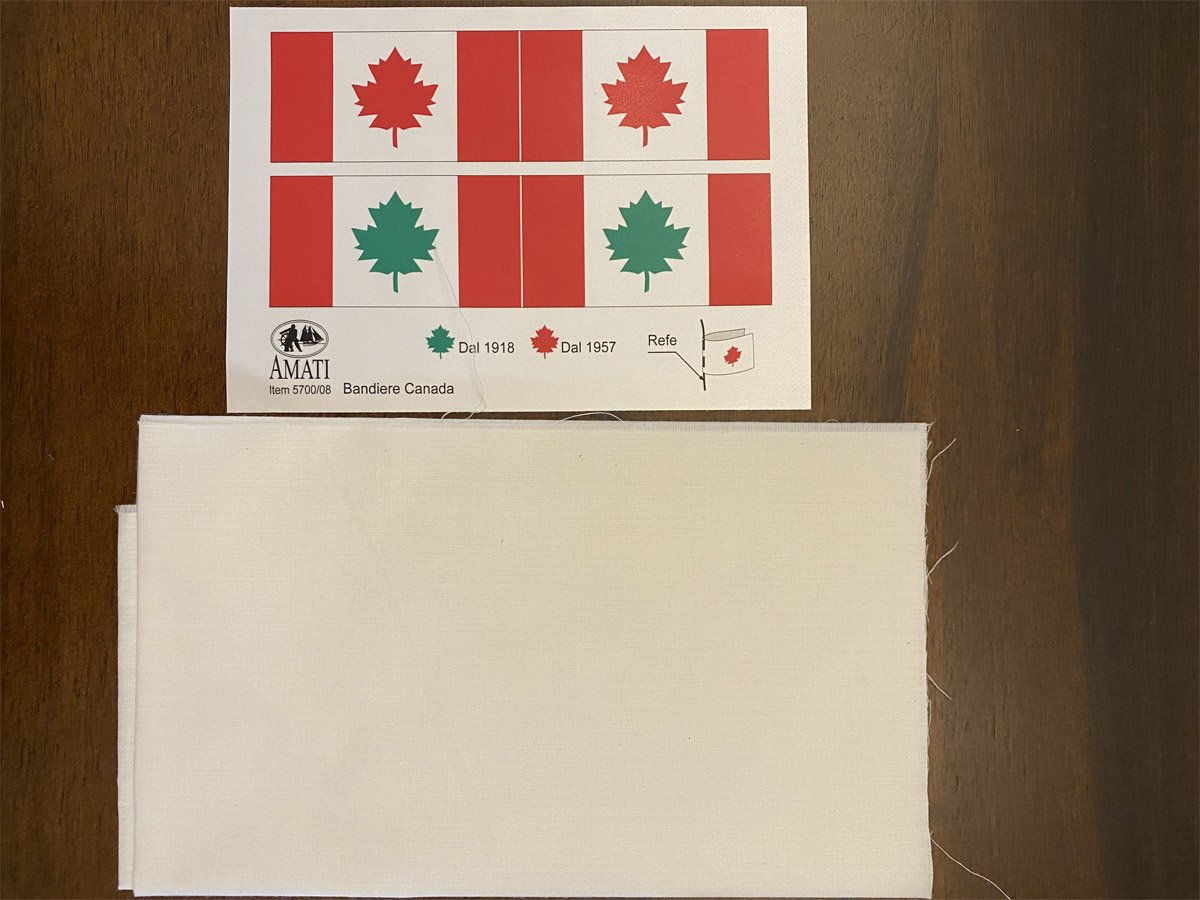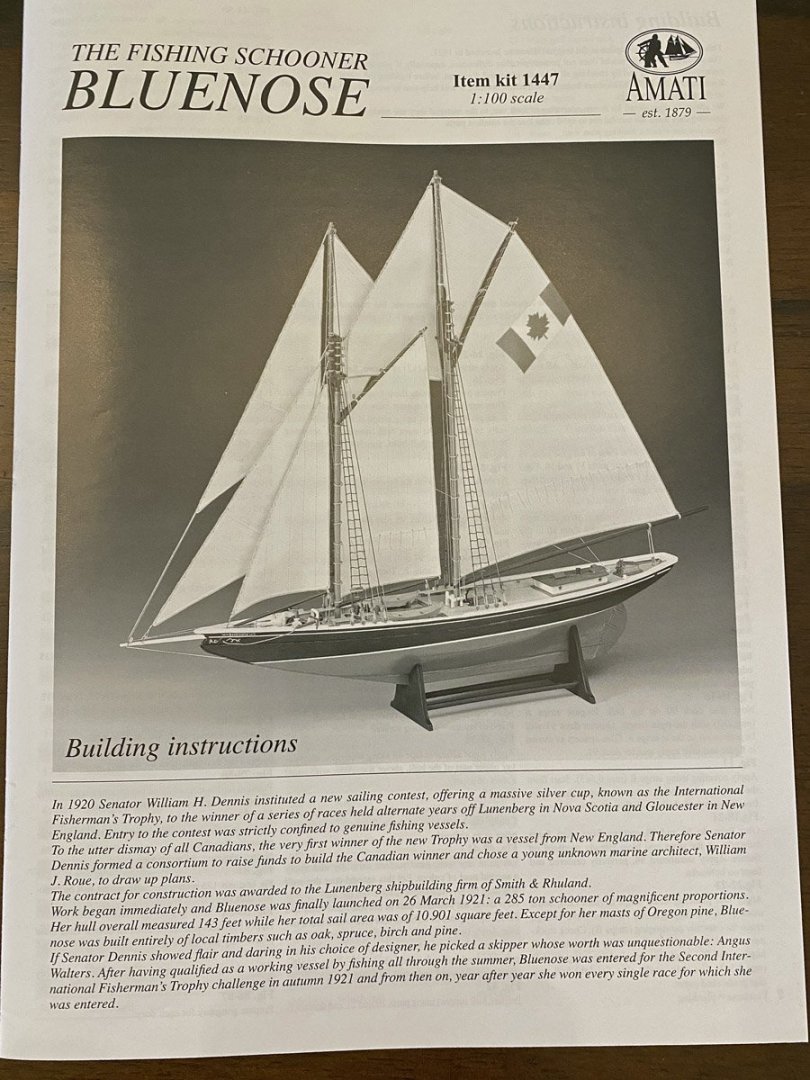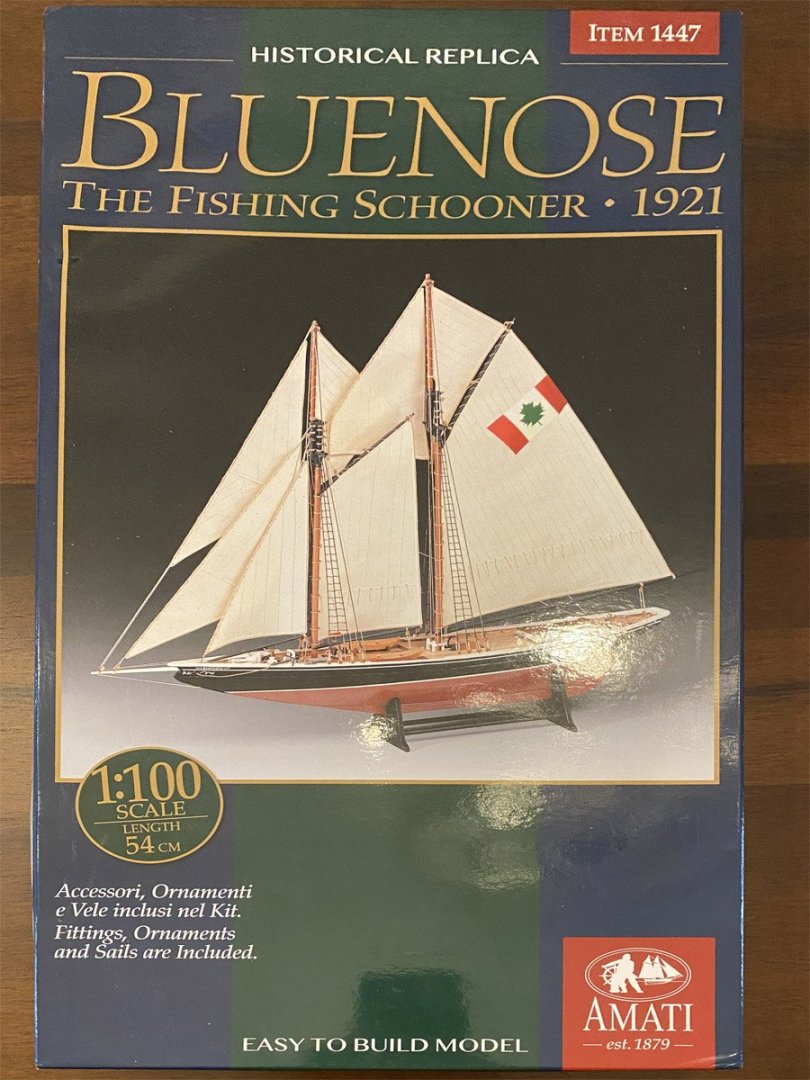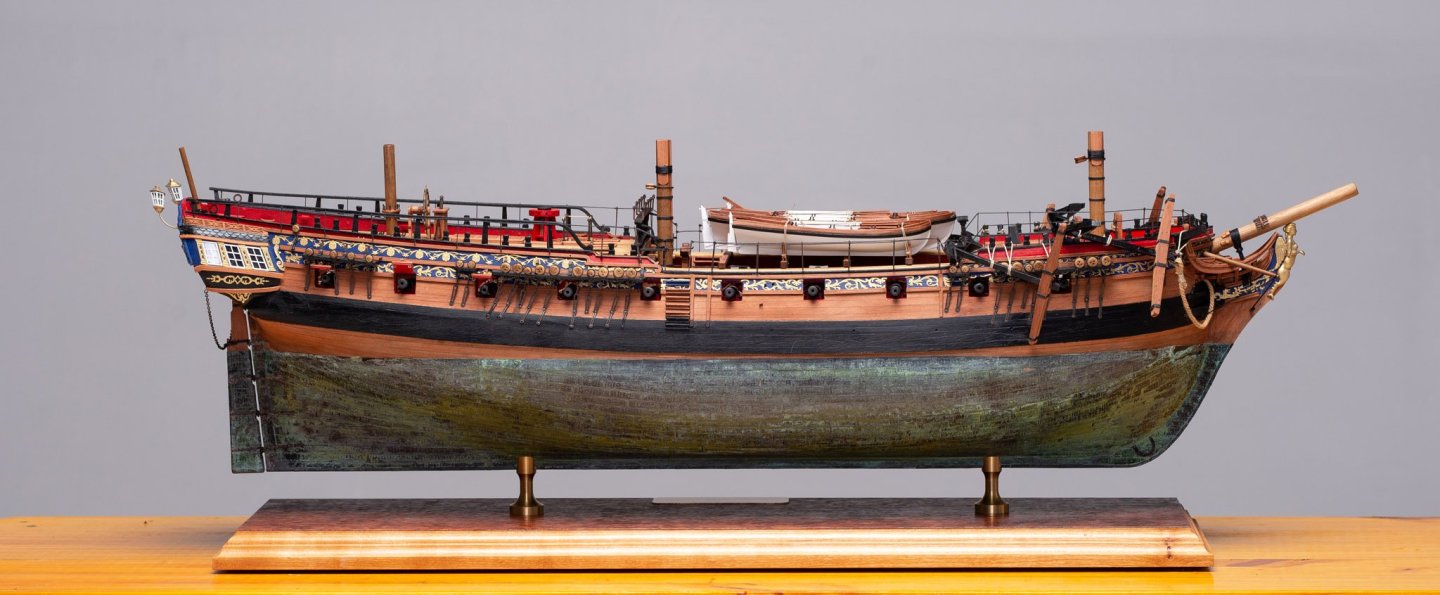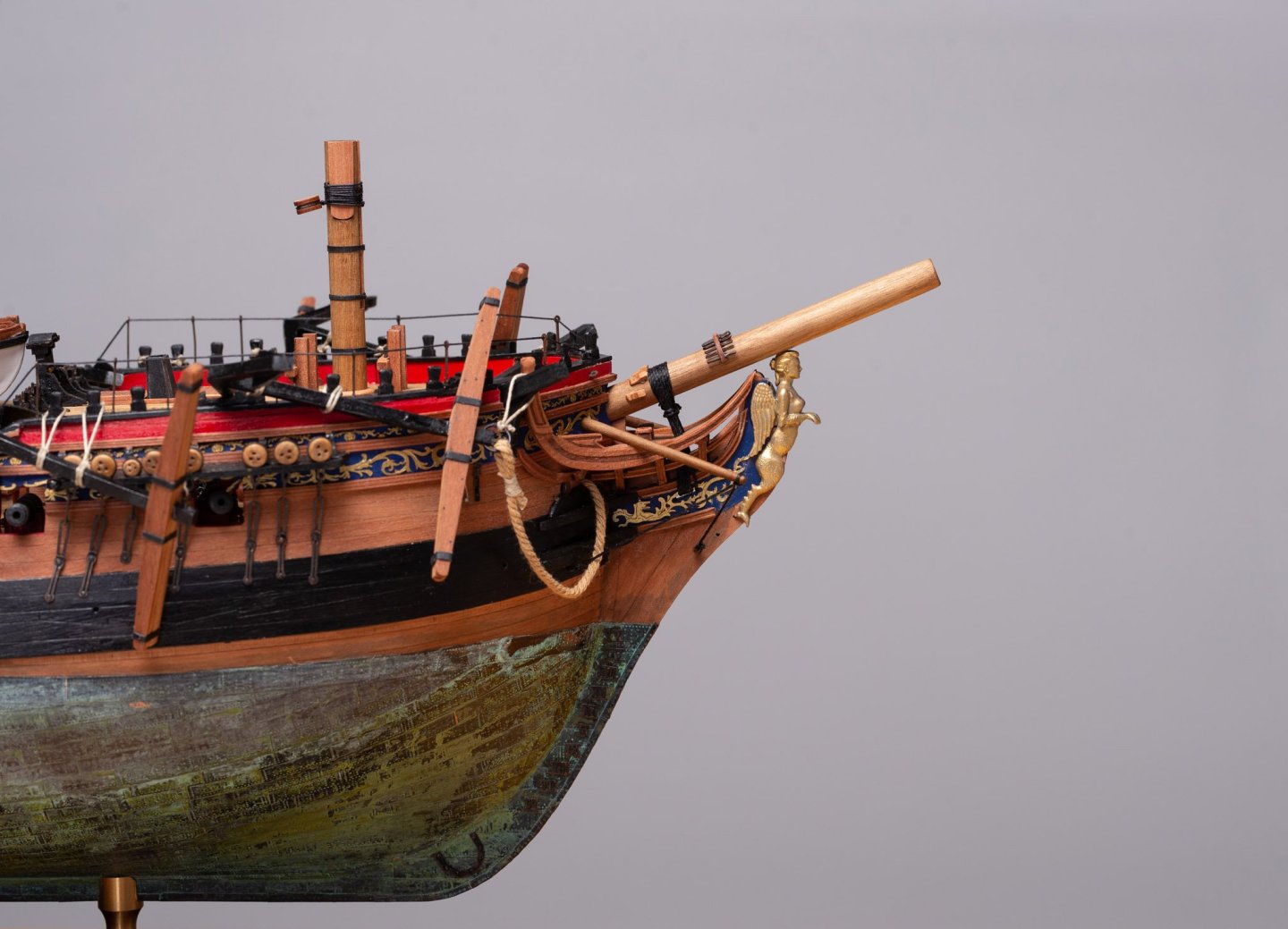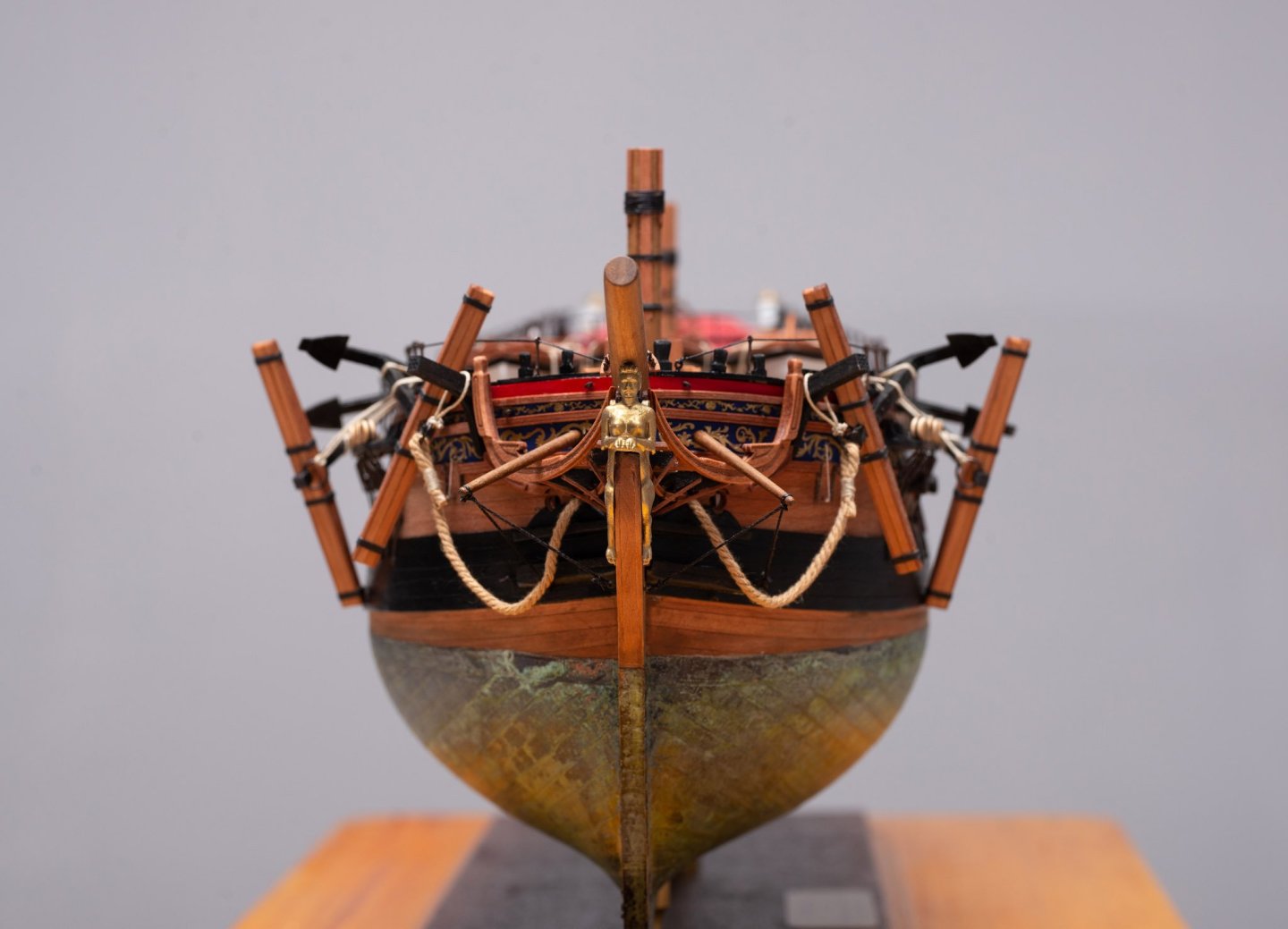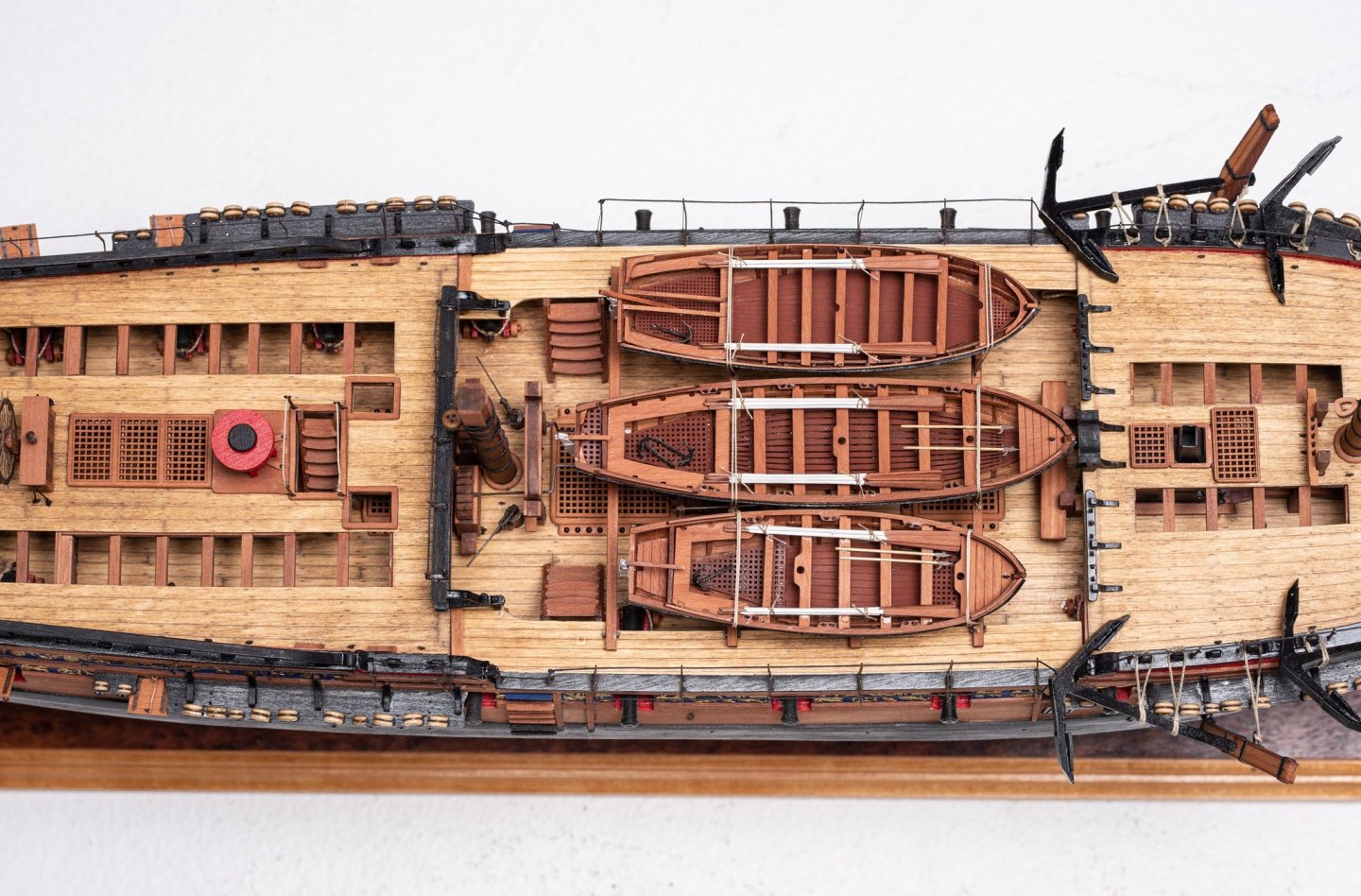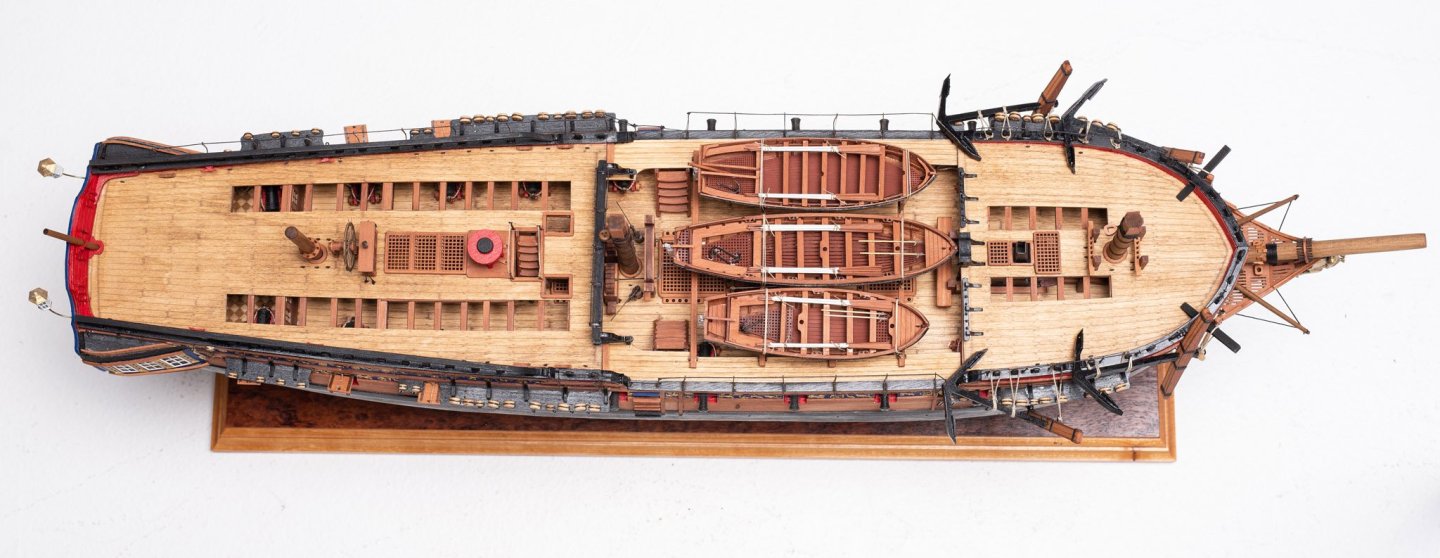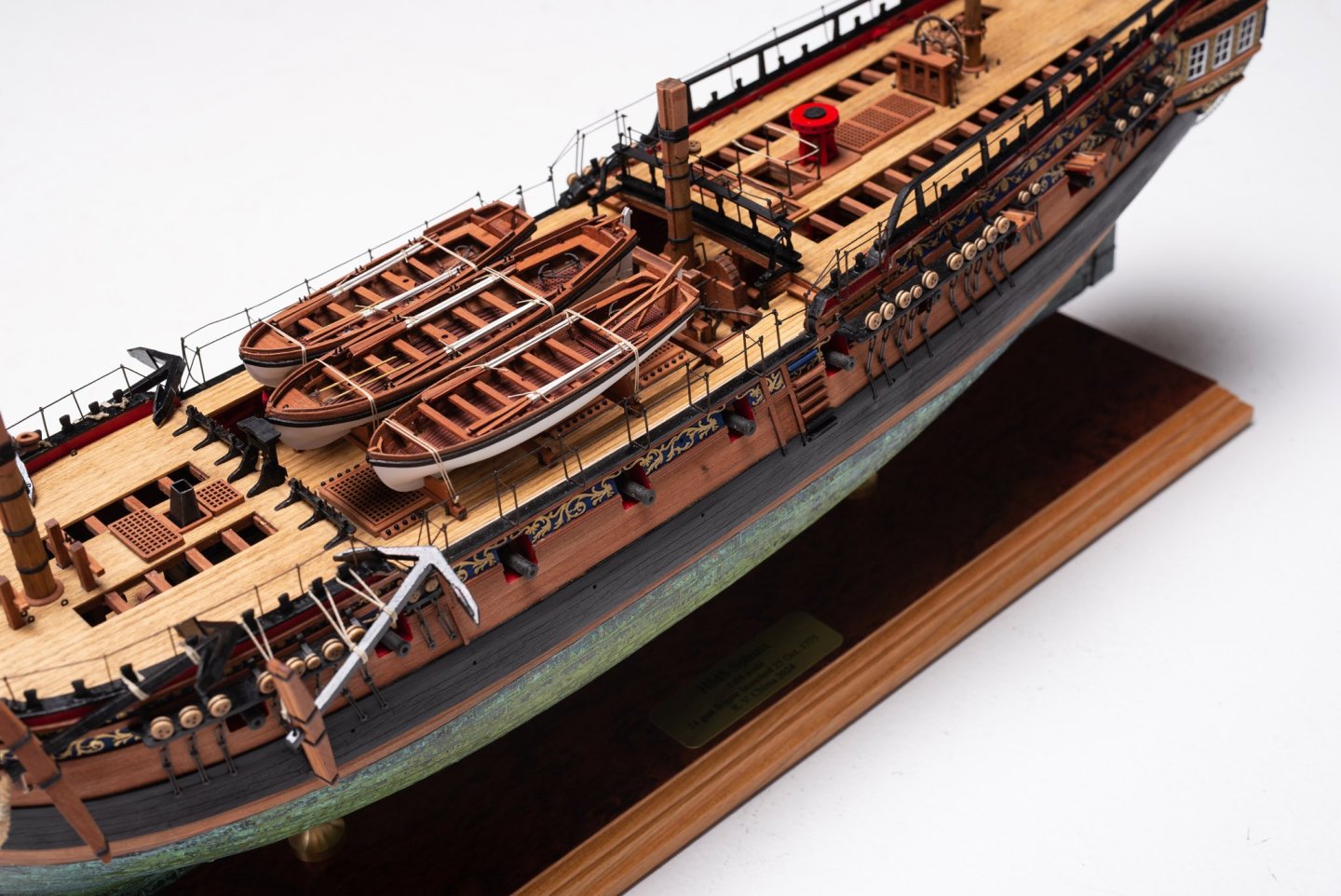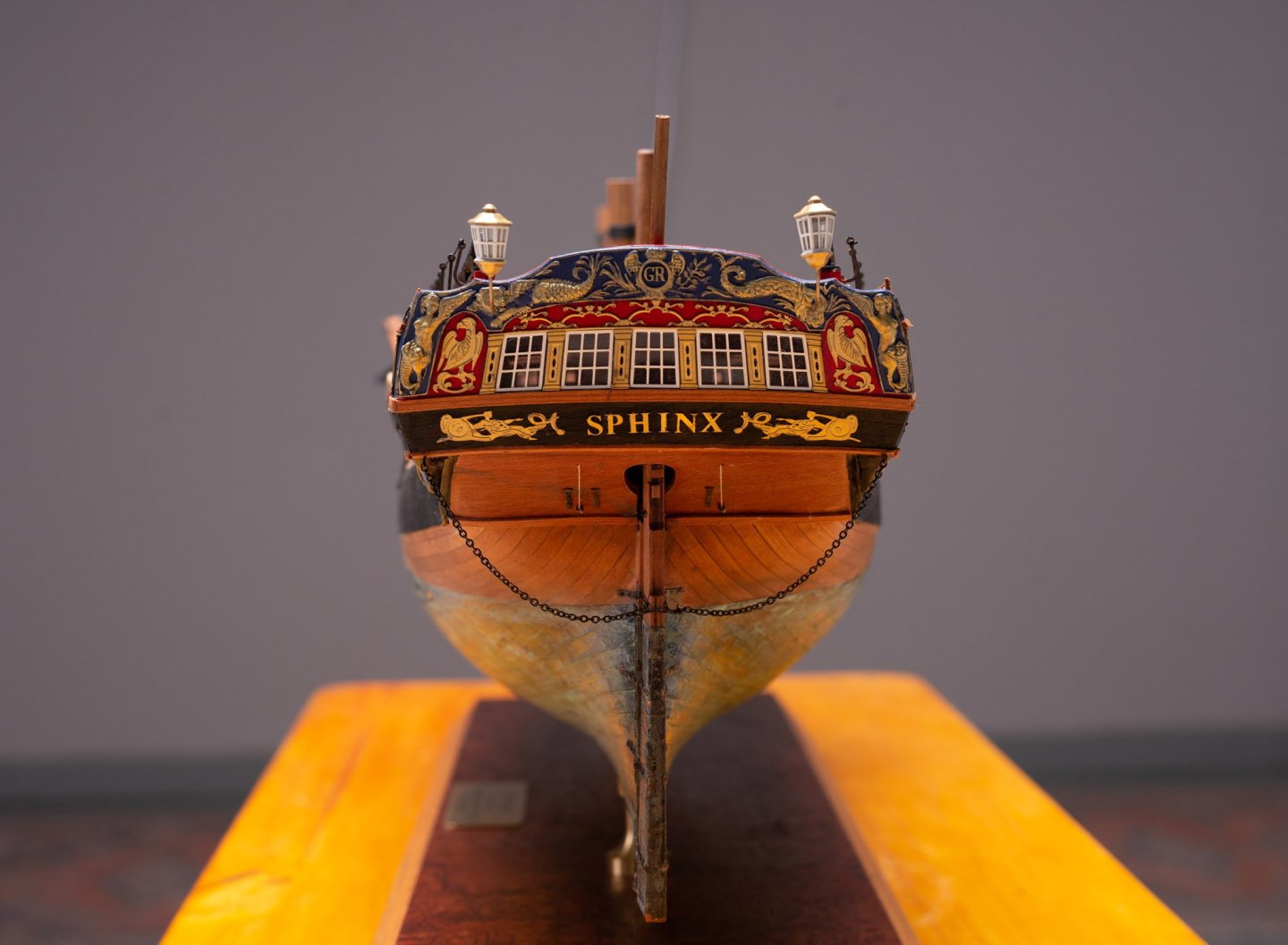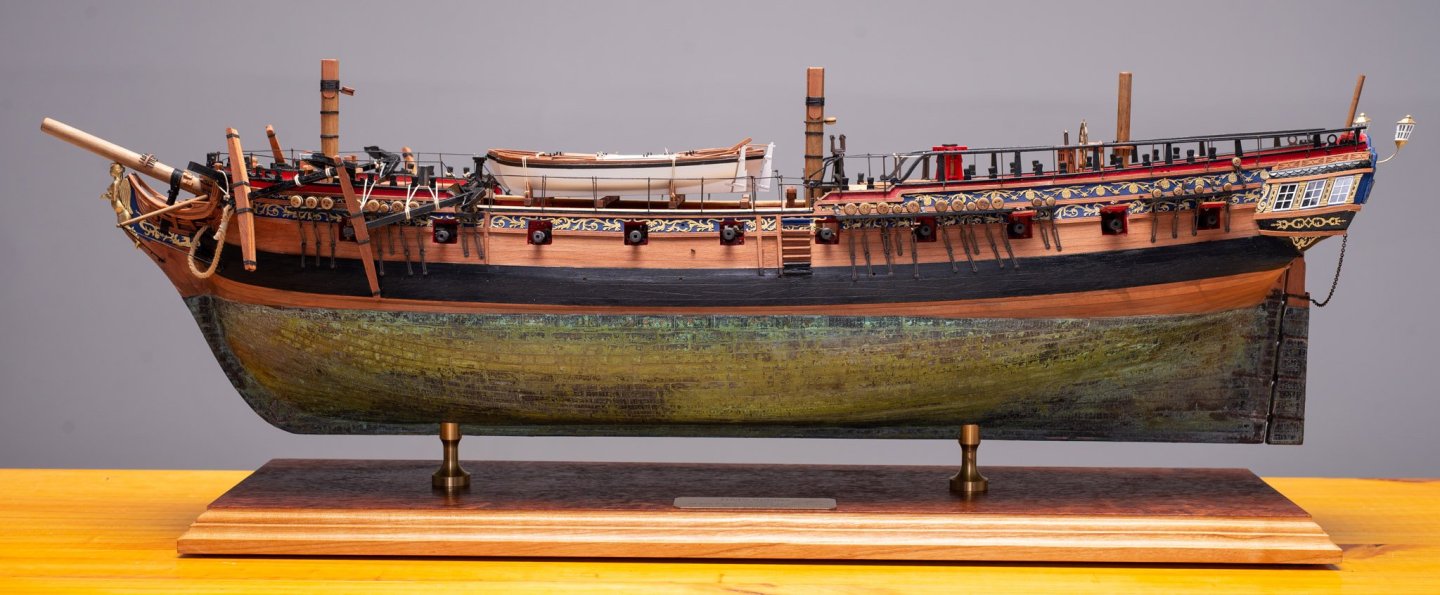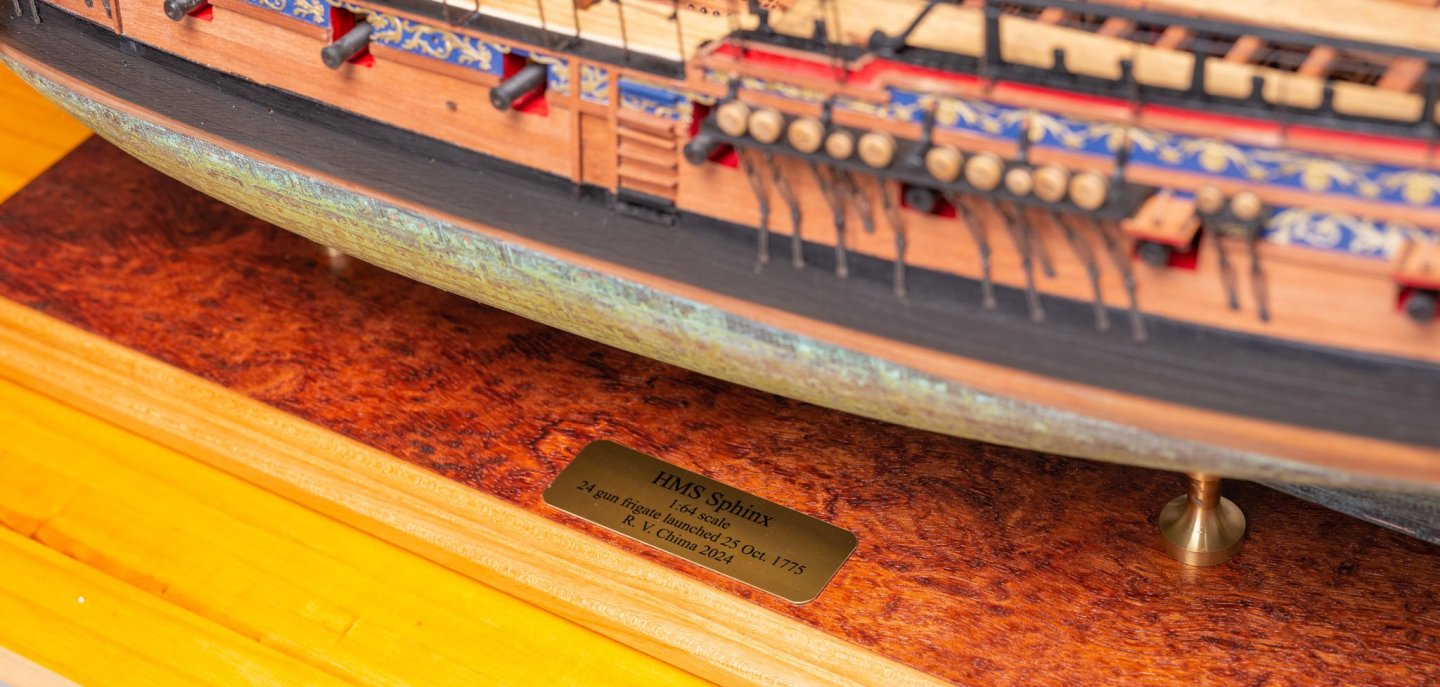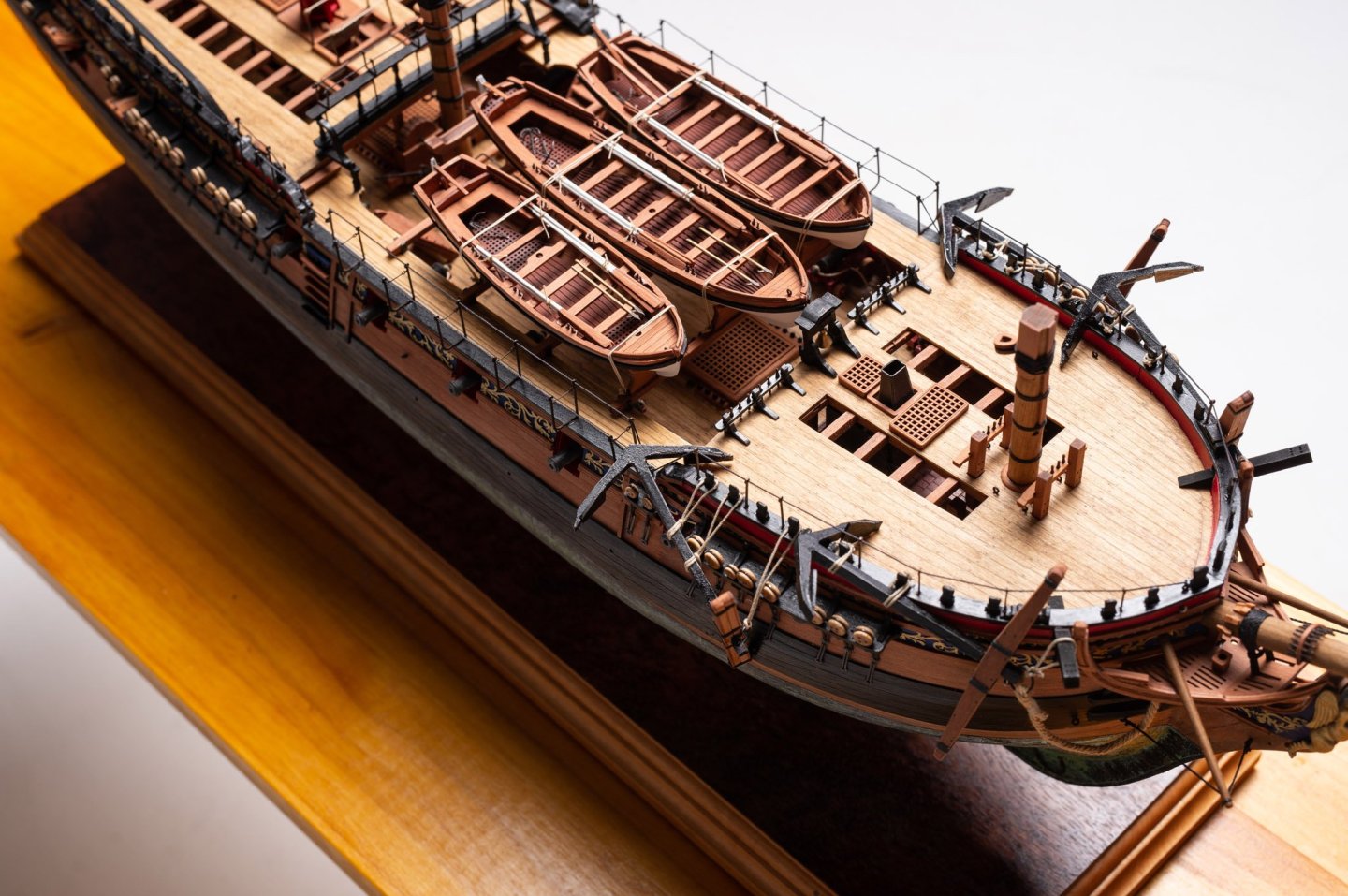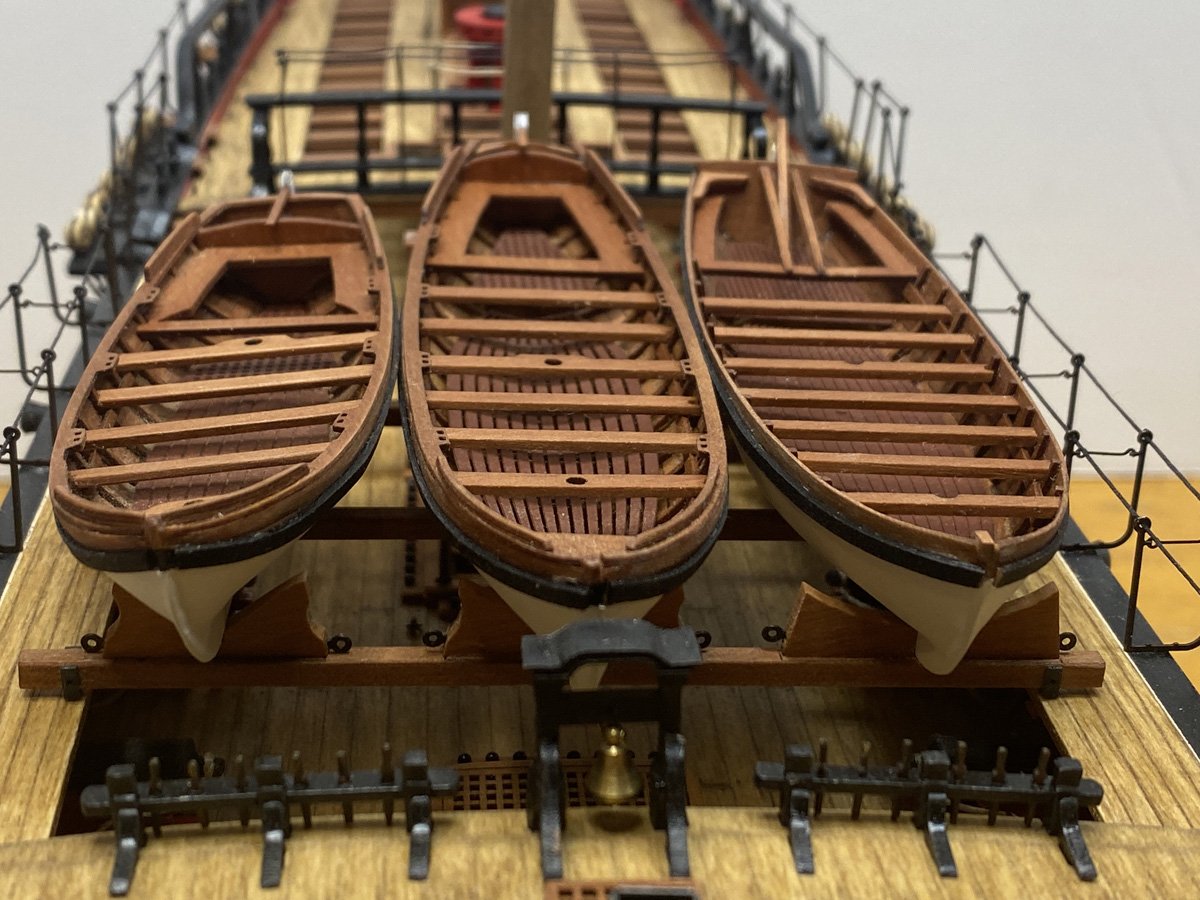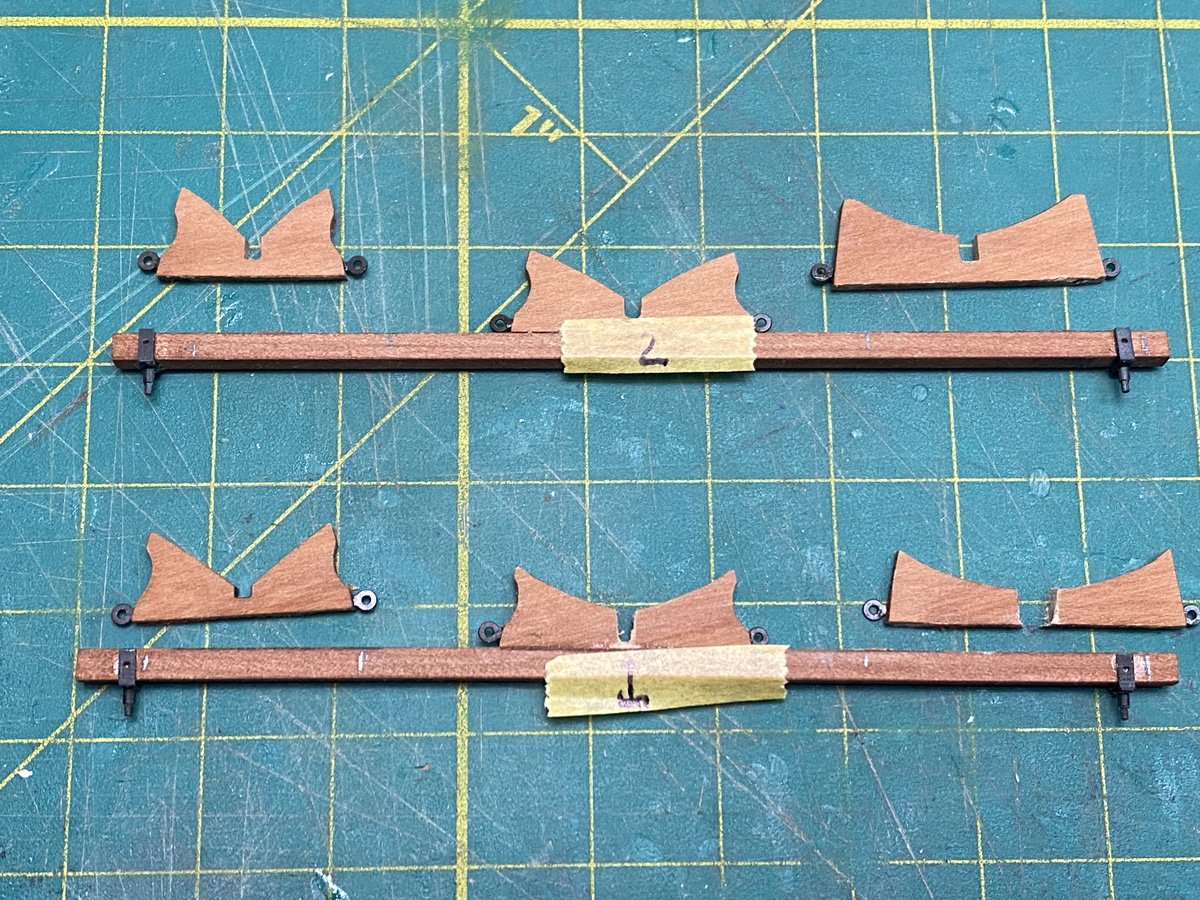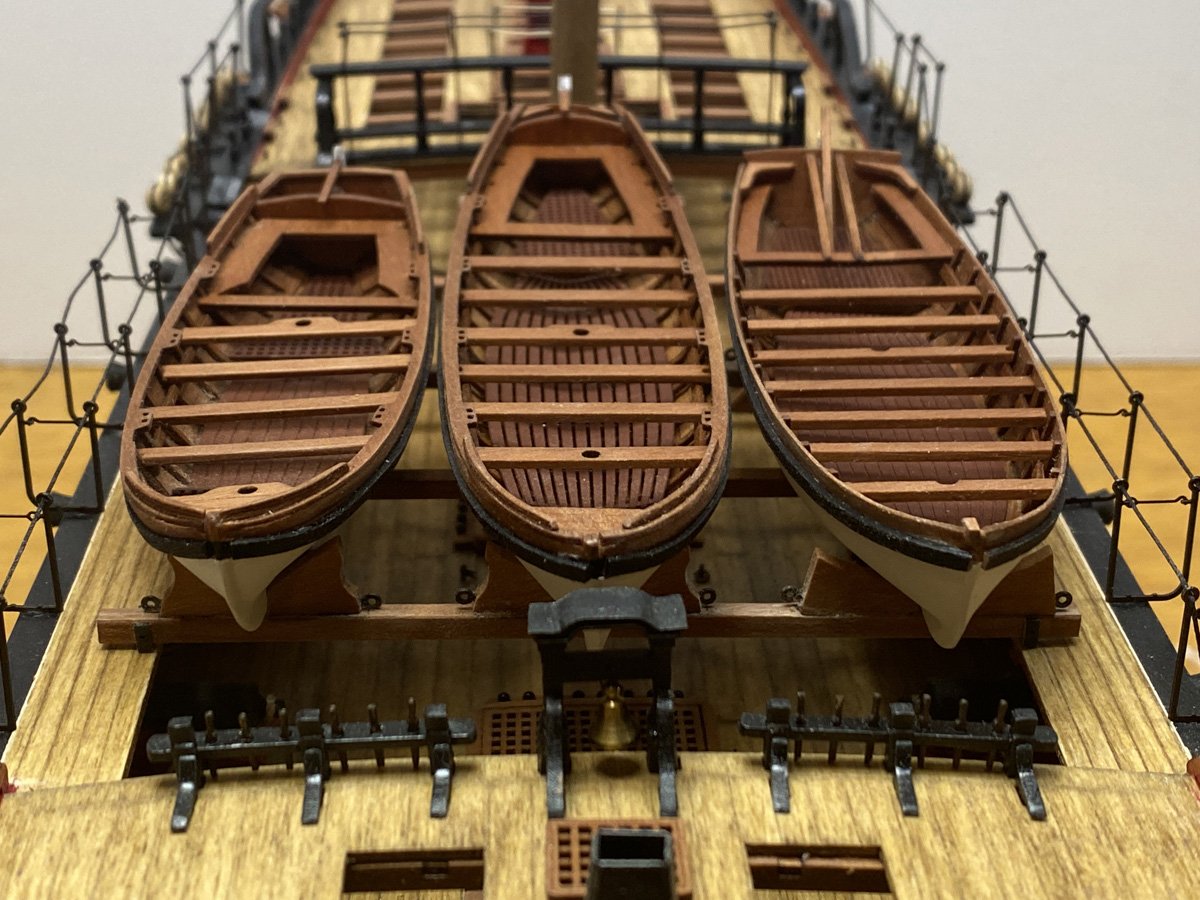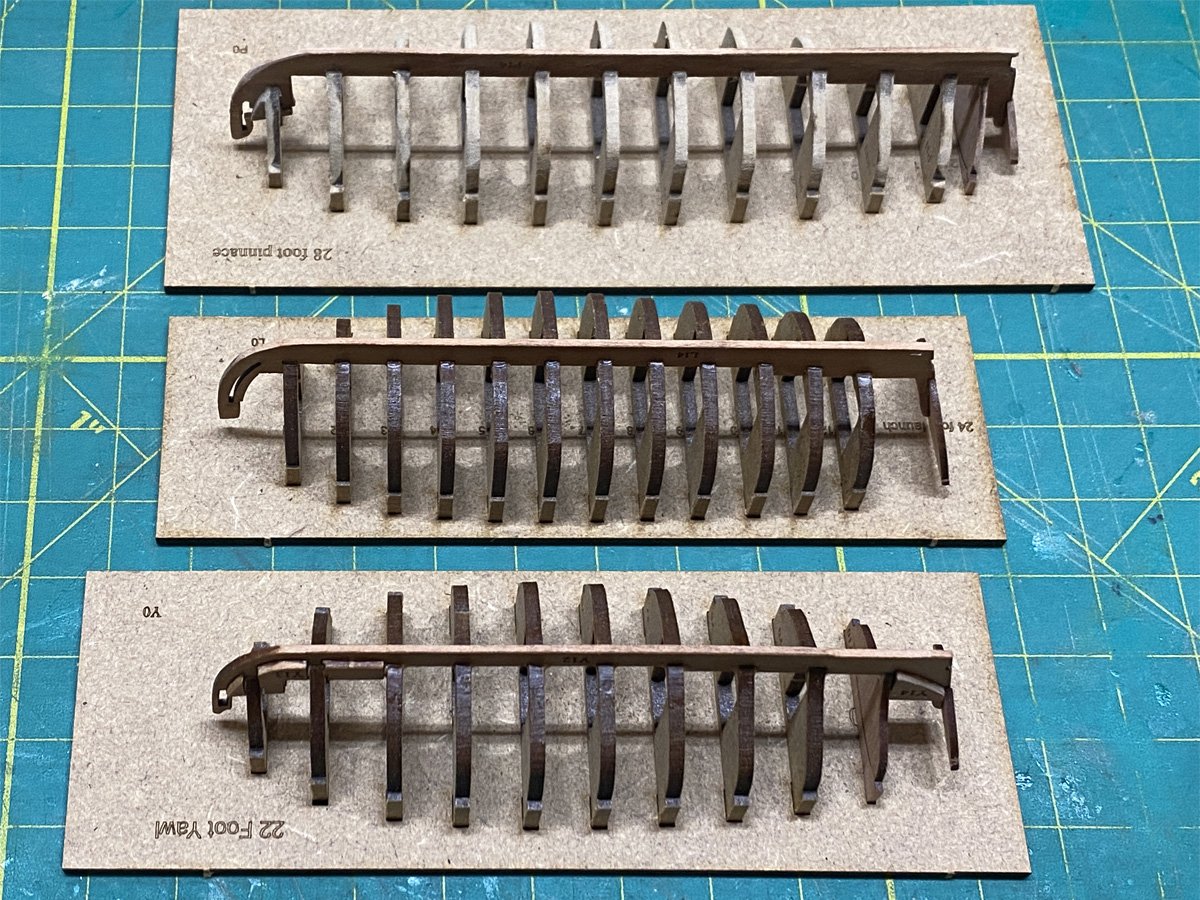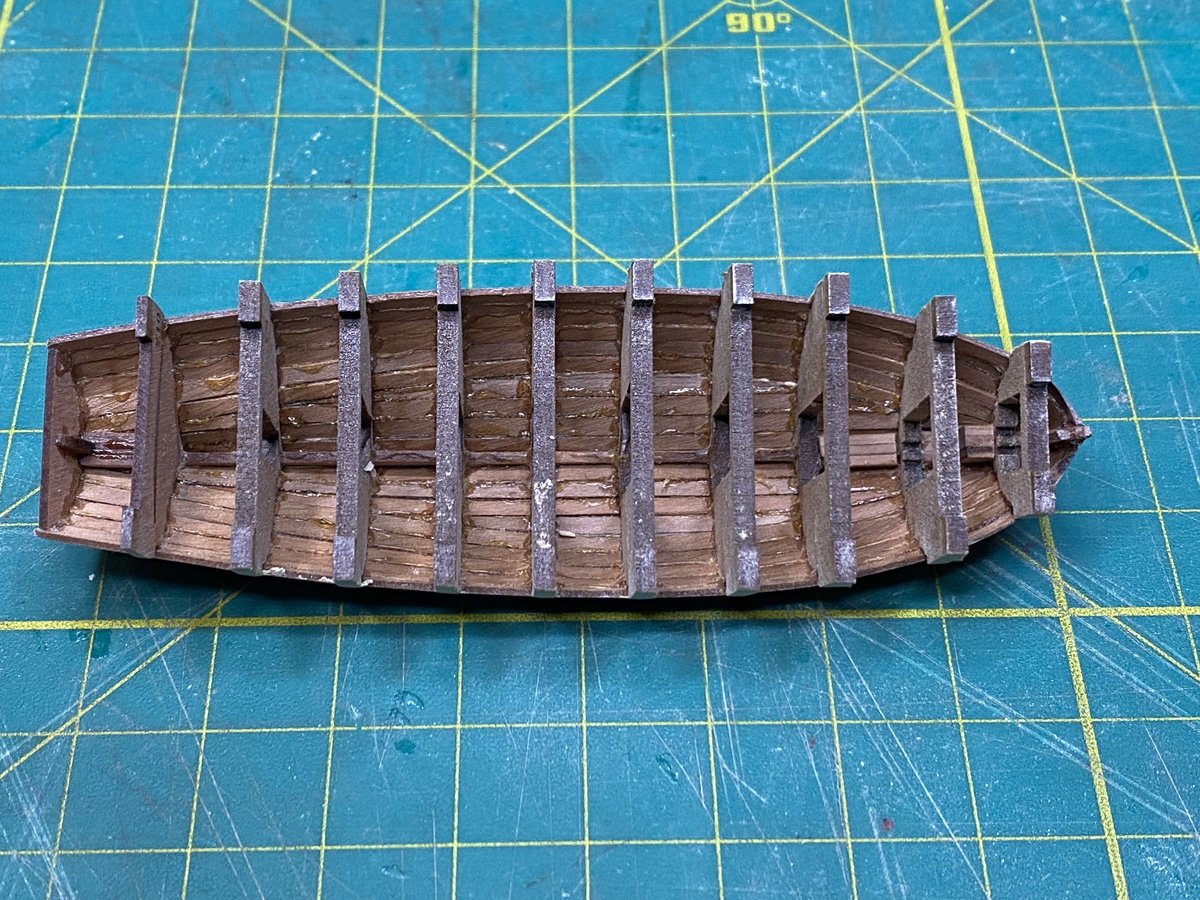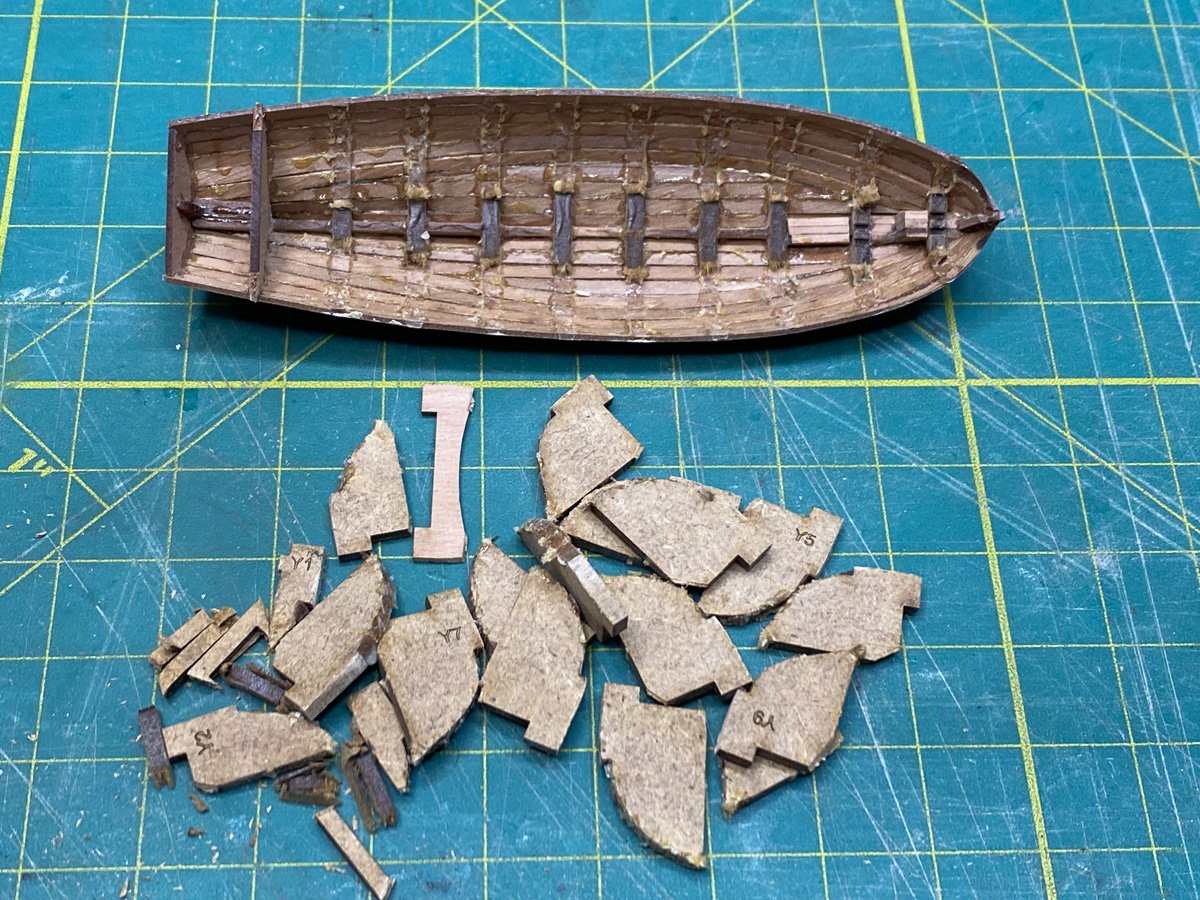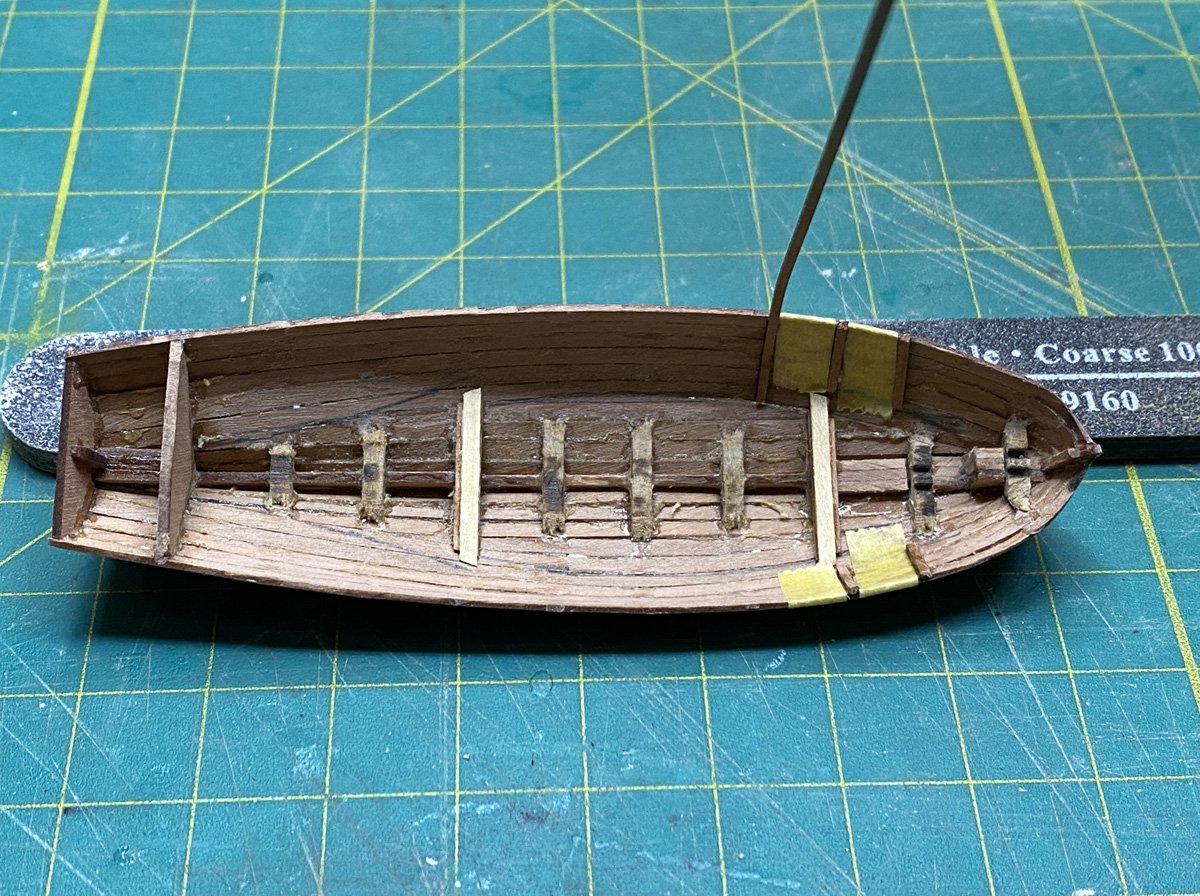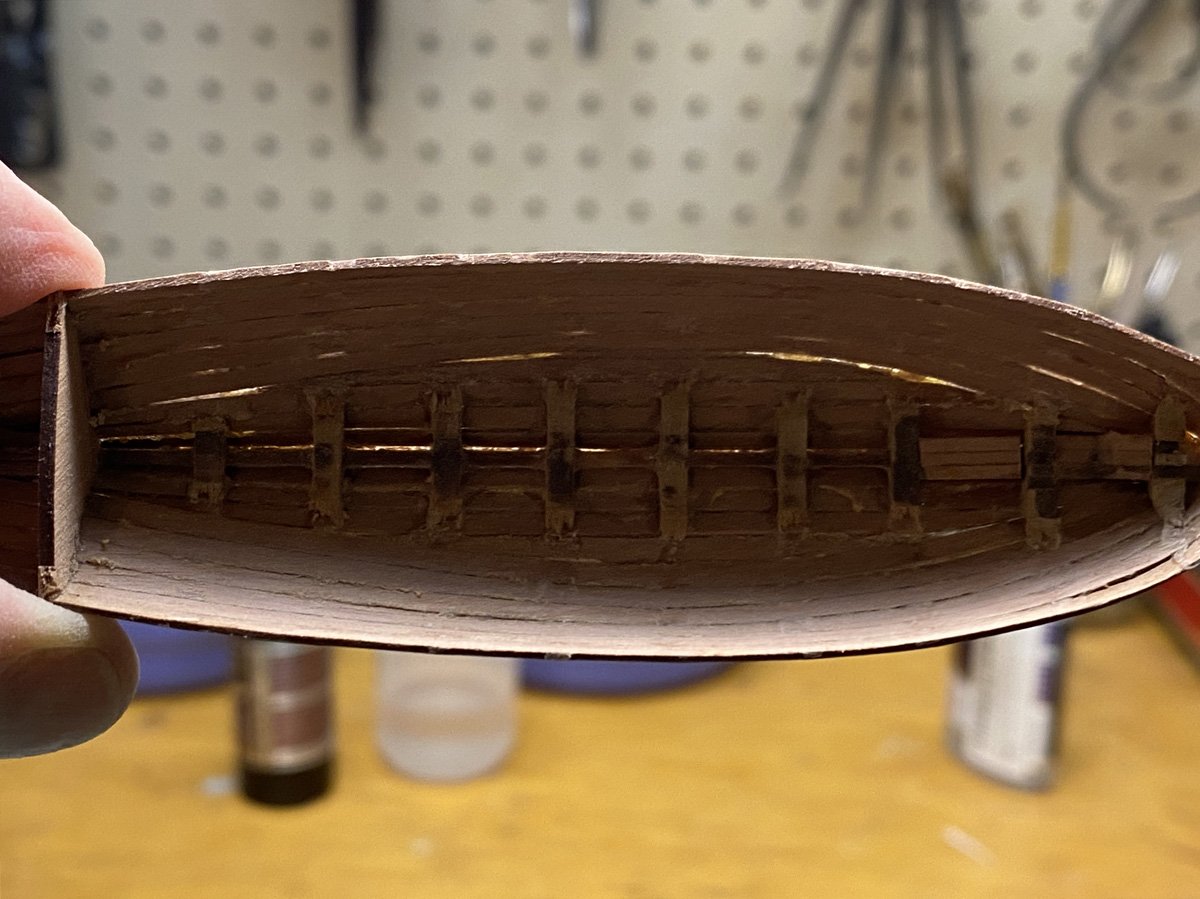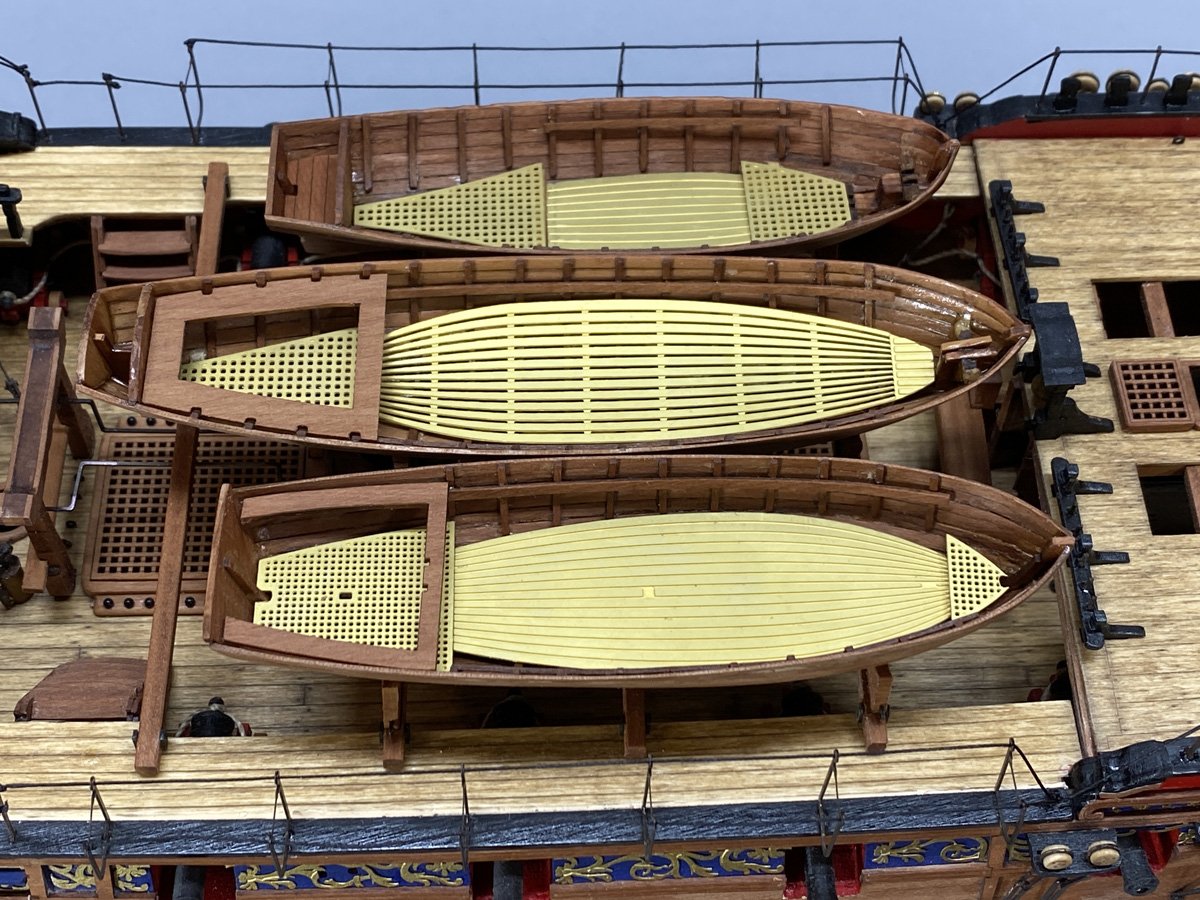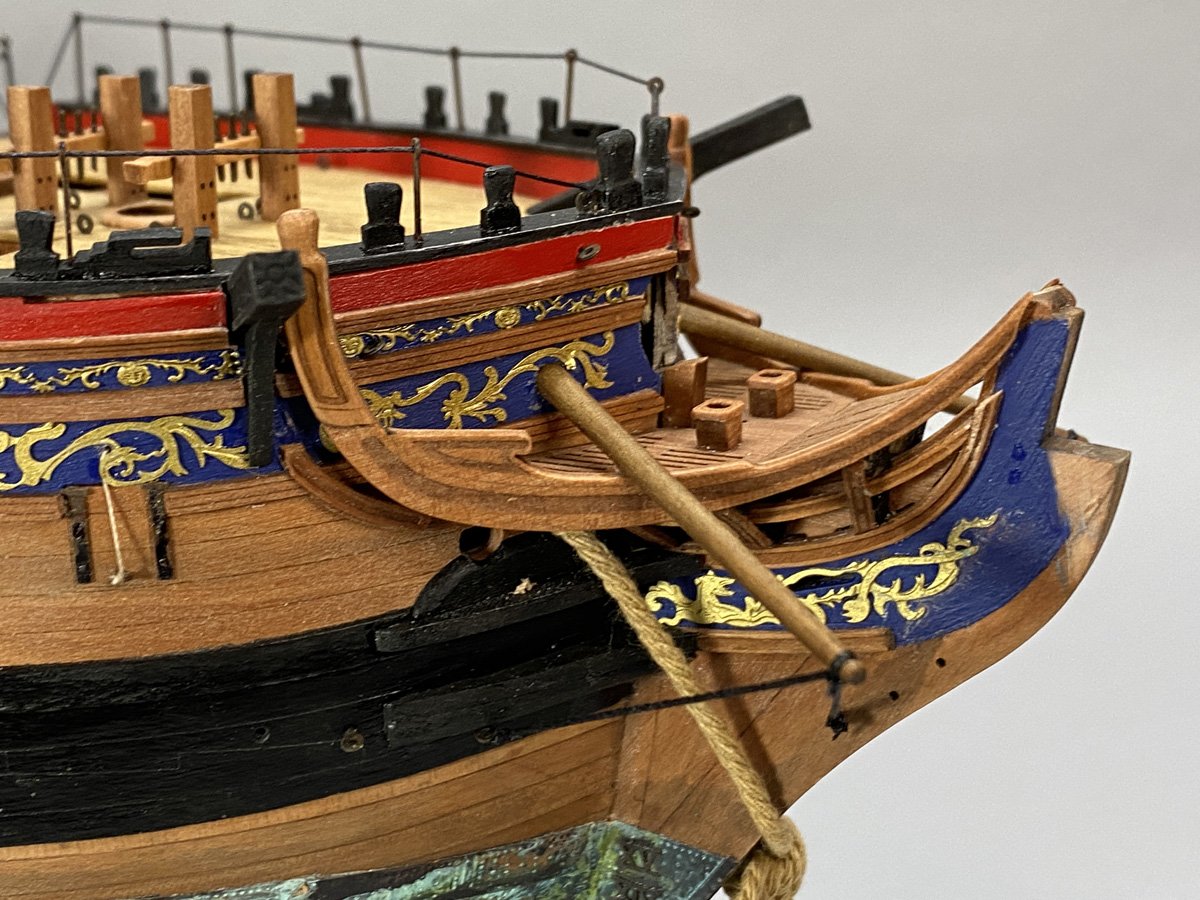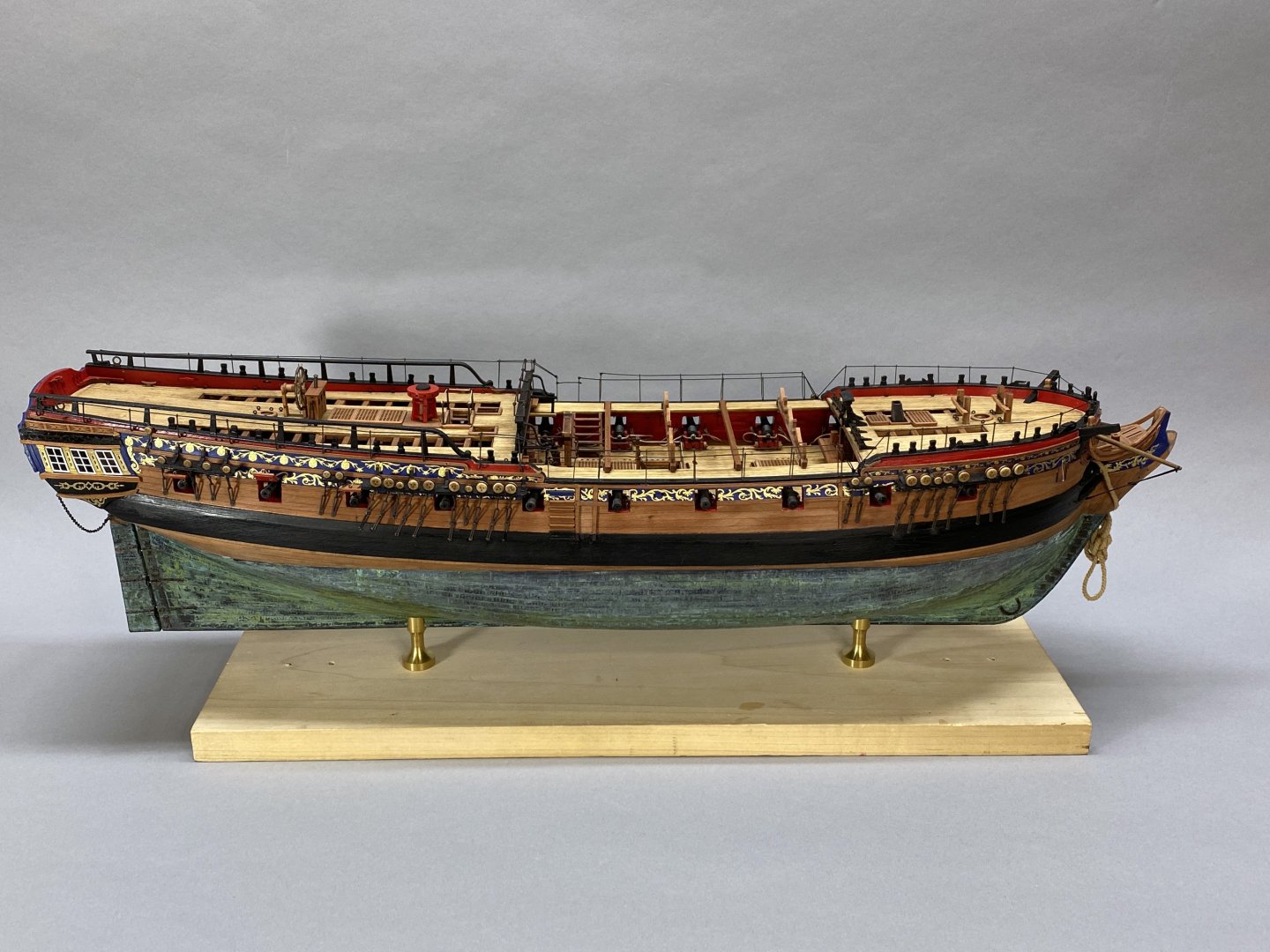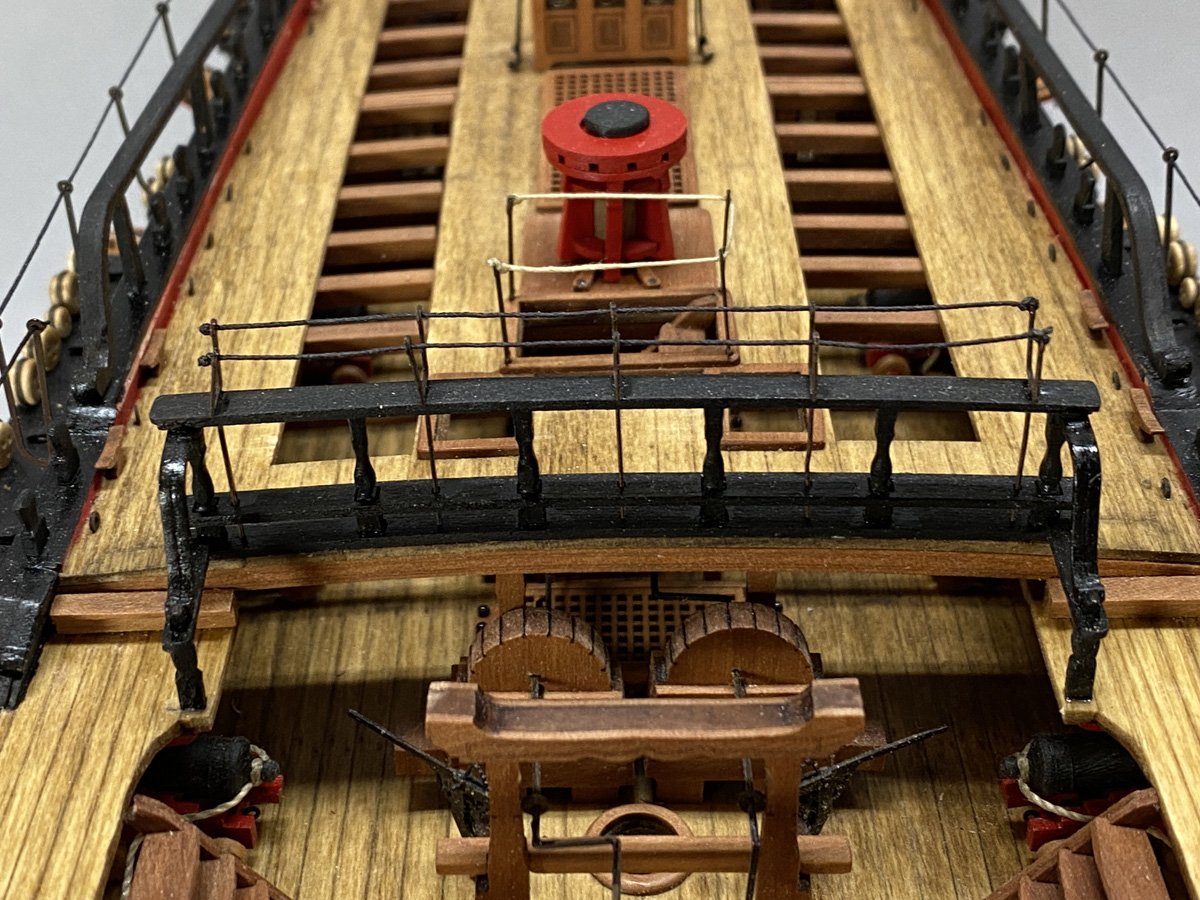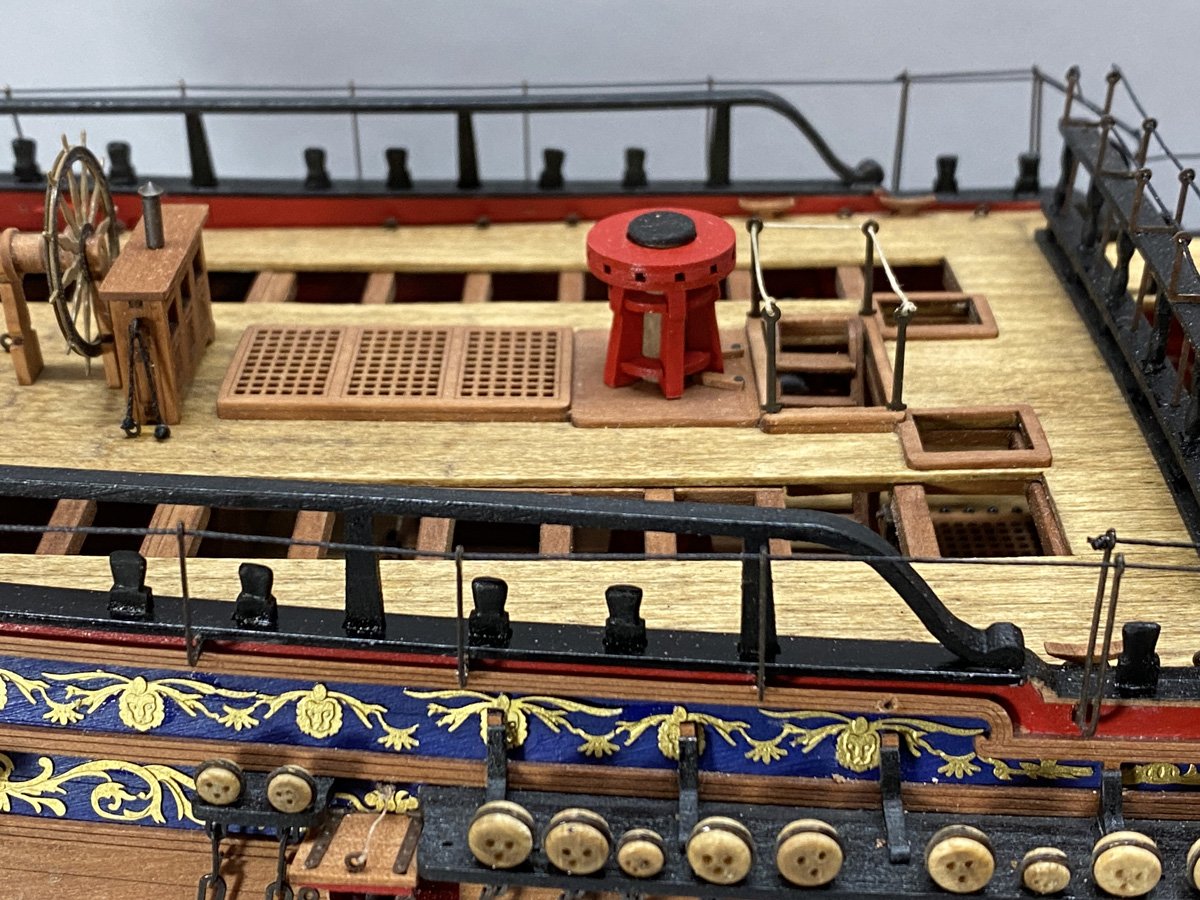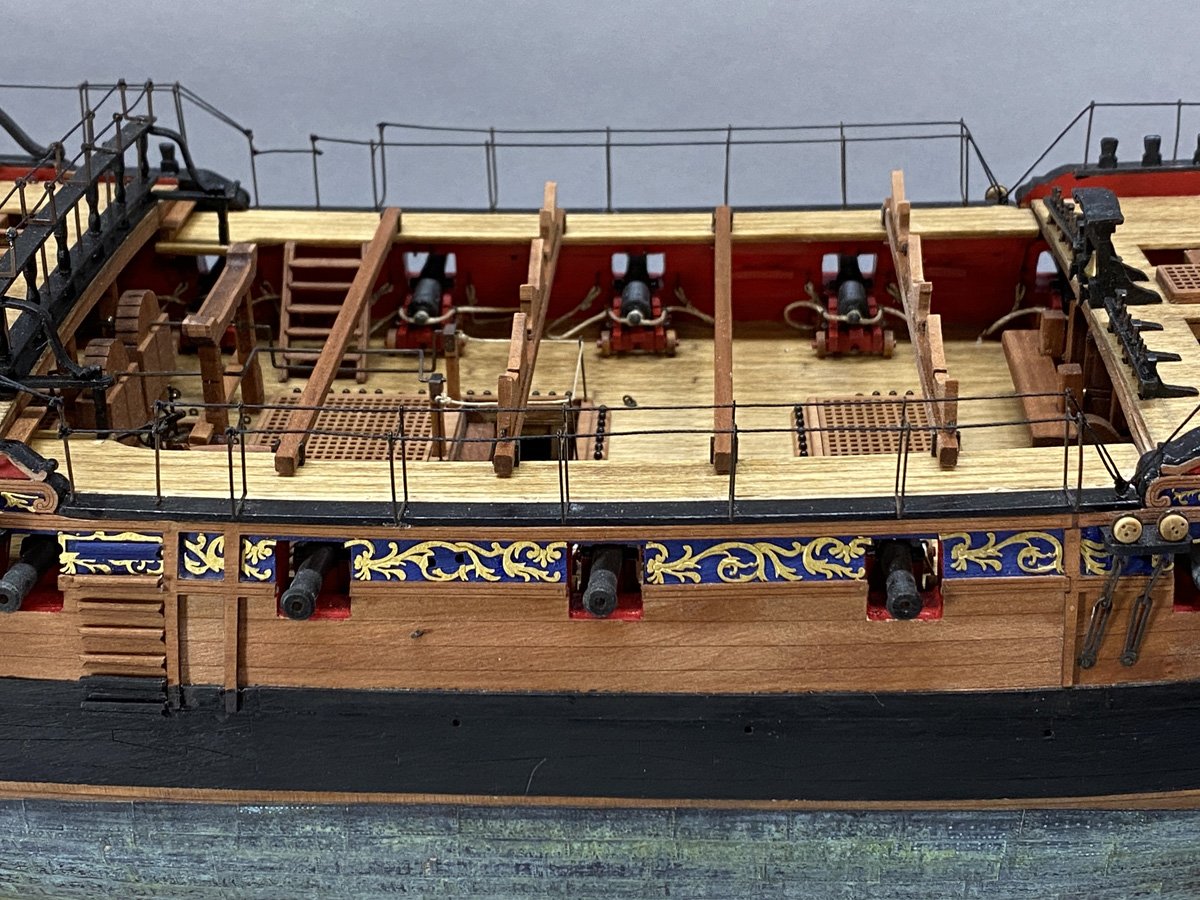-
Posts
695 -
Joined
-
Last visited
Content Type
Profiles
Forums
Gallery
Events
Everything posted by rvchima
-
Bowsprit with Blocks Re-positioned That looks a lot better. And 348 clove hitches later, I can tell that it is going to be difficult to keep these skinny masts vertical while I attach the remaining standing rigging!
-
Poor Instructions and Plans I made the bowsprit with two blocks attached to the end according to the instruction manual. I attached it and then noticed two lower stays on the plans. There was barely room to tie them on. Looking at other builds on MSW it is apparent that there should be several more stays below the bowsprit, but none are shown in the plans. Bowsprit from the instruction manual. My current bowsprit with lower stays. Now I realize that two stays for the jib and flying jib have to fit in there somewhere, and I won't have room. The plans show a little space between the blocks. The photo on the box shows even more space. Bowsprit from the plans. Bowsprit from the box cover. It looks like I will have to do some deconstruction to move those blocks apart. I think I will also use some thinner line for the lower stays.
-
Stepping the Masts The false keel in this kit is narrow and the slots for the masts and the holes in the deck were too big, so the masts would not stand upright on their own. I came up with a complicated way to set the masts vertical and hold them in place while I glued them. I hung a line from the ceiling with a screw eye weight to set the vertical. I put a heavy level across the deck, and braced it to hold the deck level. I attached a stick to the cross tree to visually set the rotation. I attached a line side-to-side across the cross tree and practiced tying it quickly. When everything was ready I removed the mast, applied PVA glue, and put it all back together. It took a whole evening to step each mast. But they are vertical. Attaching Deadeyes and Ratlines I made a deadeye spacer from two butterfly pins and a scrap of wood as thick as the spacing between two holes on a deadeye. The photo shows how it works. The mast stays are now attached and I am done with half of the ratlines. I worked for a fireworks company all through grad school, and everything was tied together with clove hitches - shell casings, fuses, lances on ground displays, etc. So I am very good at tying clove hitches, and the ratlines are coming along quickly. The Amati kit comes with two spools of line, thick and thin, and both tan. I will use the thin for running rigging but am using other black line that I have for the standing rigging.
-
Viking Cruise Lines River Ship vs. Bluenose In early July my wife and I took a cruise on the Main river through Germany on Viking Cruise Lines. They have 76 longships, all 443 ft long. The Bluenose was 143 ft long. Here is what it would look like next to our ship docked in Würzburg, Germany. It would not fit under the bridges!
-
That's for sure! After looking at some of the 1:64 Model Shipways Bluenose builds I've realized that Amati just left off a LOT of small details on this kit. I'm kind of sorry I didn't go with the larger model.
-
Masts, Gaffs, and Booms I tapered the masts, etc. chucked on a lathe using sand paper. At first I struggled with how to seize a line to a block and attach it to a mast, until I remembered that I had posted a very simple way to do that under my Endeavour build. It's cheating but it looks fine, goes fast, and hardly wastes any line. All those pieces are done and ready to install.
-
Anchors The Amati kit came with two cast anchors but no stocks or chain. I made stocks from some scrap walnut, and I had a long piece of brass chain that I blackened. The instructions show the anchor tied to the cathead by the shank, and a rope from the ring to the hawsepipe, where it disappears. I searched several Bluenose builds on MSW and saw chains leading to the winch, around the engine box, and into a chain box (or possibly into a locker below the deck?) I made something like what GGibson shows in this post.
-
Dories - 13 hours over 4 days The dories are made of 4 pieces of laser cut plywood assembled over a 4-piece form. The actual construction was pretty simple but I added some details that took a lot longer. Like these oars. They're 25 mm long and the handles are 1 mm dowel. They tended to break where the handles attach to the blades. The floorboards are thin walnut strips. The spacing between the strips is exactly the size of my push pins. I attempted to paint the dories by hand to avoid setting up my airbrush. When they still looked uneven after 7 coats of Model Master insignia yellow acrylic, I got out my airbrush. In 10 minutes they looked great. The green was masked off but drawn with a permanent marker. The Bluenose often sailed with 12 dories stacked 6 high. but 2 was enough for me.
-
Oops, Missing Rail I've been working on hatches, cabins, etc. and realized that I had neglected to add a second layer of railing around much of the hull. It wasn't hard to add, except where it interfered with 8 deadeyes amid ship. I had to wiggle them all loose, add the railing, paint it, and replace the deadeyes. Hatches, Cabins, etc. The tiny cabin is about the size of a Monopoly house and difficult to hold while working. The rings on the hatches are actually eye bolts folded 90 degrees and glued in holes. I did find some belaying pins. They are a bit long where the railing is a bit low, so I will have to improvise when tying lines to them. Main hatch and dory racks. The dories are built and currently being painted. The winch was made from several random pieces - aluminum tube, tiny round disks, 2 cast metal pieces, 2 turned brass pieces, and a piece of photo etched brass.
-
Back to Work I just returned from two weeks in Europe, traveling from Prague to Paris mostly on a river cruise. After mowing the grass I got back to work on the Bluenose. The Amati kit comes with a fairly ugly stand so I spent the last couple of days making a nice one out of cherry. I shaped dowels to make the pedestals. Old stand New stand The instructions say to wrap the deadeyes with fine brass wire. That seems simple enough but it took a few tries to get the hang of it. I darkened the wire with Novocan brand patina for stained glass. The wires go through the rails and into the deck, and are attached with CA. The remaining holes are for the ropes, but there are no belaying pins with the kit! The instructions just say to run the ropes to the appropriate holes. I hope I have some belaying pins in my spares box.
-
Hull Painted, Railing Installed - 23 days, 55 hours The hull was painted with three coats each of Rustoleum Colonial Red, Krylon gloss white, and Krylon gloss black from rattle cans. The rails and interior were brush painted with gloss white acrylic. I am leaving for Europe in a few days and rushed to get this all done, but probably should have taken my time. I can see a few seams between boards and a few fingerprints on the black areas. Not bad but I could do better.
-
Second Planking Complete I started at the top rail and worked towards the keel. The thin second layer of 0.5 mm walnut planks were amazingly flexible. I just glued them directly to the first layer with CA. No tapering necessary. After lots of sanding, crack filling with Famowood, more sanding, two coats of Aqua Coat, and more sanding, I think I am ready to paint the hull. At least I'll see how it looks after a coat of primer.
-
First Planking Complete - 14 days, 31 hours The second layer of planking is walnut, 3mm wide x 0.55 mm thick - not much material to sand down when I screw up. And why walnut if it's going to get painted anyway?
-
There are so many Bluenose build logs on MSW that I debated whether to add another. I am already glad that I did, since I've learned that the Maple Leaf flags that come with the kit are incorrect. However, I looked at the web sites for all the other Bluenose kits and guess what? They all have Maple Leaf flags! What gives?
-
Trevor, Thank you so much for the history corrections! I'm just repeating the text from the Italian instructions. Regardless of her win/loss record, she sure is a beautiful ship. Thank you also for the tip on the flags. I will certainly not use the ones supplied with the kit, and if you can suggest any alternatives I see what I can do.
-
Starting on the Hull and Deck The frames popped out of the laser-cut ply and fit perfectly on the keel. I planked the two thin plywood sub decks by gluing down full-length strips and then notching them with a chisel to make individual boards. The technique is described here. I stained the decks with two coats of Minwax Golden Oak and finished them with Minwax Polycrylic satin from a rattle can. When I test fit the decks on the keel they didn't line up in the center. Low and behold, the keel was warped about 4 mm off straight. Darn, I wish I had noticed that before I added all those frames. I ended up notching a piece of poplar to go around the frames. Clamped to the keel from below it held it straight while I glued the decks in place. The decks held the keel straight afterwards. I've started the planking using the technique described in the book Ship Modeling Simplified: Tips and Techniques for Model Construction from Kits by Frank Mastini. Basically you glue the planks to the frames with CA, and glue the planks to each other with PVA (carpenters' glue.) The CA hardens in a few seconds and holds the planks in place, no nails needed. I do about three frames at a time. Oh yeah, I have a hot plank bender now and am using that to roughly shape the planks before attaching them. The kit comes with a simple stand, but I usually prefer to mount my models on a permanent base - much easier to handle during construction and afterwards. But the sub keel on this model is just 2.25 mm thick, too thin for screws. I don't know what I'll do - maybe turn some wood pedestals and glue in place later?
-
What's in the Box Seems like not much for €106.99, but that's what kits cost anymore. I love the "EASY TO BUILD MODEL" text on the box. Easier than many of the models I've built lately, but with a planked hull and full set of sails this will be anything but easy. Planks, dowels, thread, blocks, and a few miscellaneous parts. Three pages of full-sized plans. Three sheets of laser-cut parts. Two flags on adhesive-backed cloth, and cloth for sails. and a booklet with one page each of instructions in English and Italian, and about 20 pages of drawings.
-
Bluenose was a 285 ton Canadian fishing schooner launched on 26 March, 1921. She was built to compete for the International Fisherman's Trophy held in alternate years off Lunenberg, Nova Scotia, and Gloucester, New England. She won the race in 1921 and every other race that she entered after that. (See corrections by Kenchington below.) She is depicted on the current Nova Scotia license plate and the back of the Canadian dime. There are LOTS of Bluenose builds on MSW, with kits offered by four companies in three different scales. I made an unofficial count of the kits listed as FINISHED. Company scale no. of logs Amati 1:100 3 Billings 1:100 2 Artesania Latina 1:77 8 Model Shipways 1:64 11 I decided to to build the Amati kit, mostly because I have built a few of their models am running out of space for larger models. Of the three Amati Bluenose build logs on MSW, only one has much detail. I will link it here so I can refer back to it later. It was completed 10 years ago, so I don't feel too bad adding another Bluenose build. Bluenose by SimonV - FINISHED - Amati - Scale 1:100 - first wooden ship build
-
I was away for a couple of weeks and didn't look in on your build. Your planking is perfect and the WOP is just beautiful on the pear wood. Congratulations on a marvelous job. If dampening the damaged area does not fix the problem, try touching the dampened area with a hot clothes or bending iron. Try it on some scrap first.
-
Thank you to everyone for the kind comments on my build. It was a challenge but also a pleasure to build such a fine kit, and always fun to share the work with people who appreciate it. Rod
- 96 replies
-
- Sphinx
- Vanguard Models
-
(and 2 more)
Tagged with:
-
FINISHED - 441 Hours, 165 Days Since my last posts I finished and attached the ships boats, anchors, lanterns, and some stub masts. I knew from the start that this would be a hull-only model. I simply don't have room in my house for another large model. @chris watton at Vanguard Models has produced an absolutely beautiful model in the Sphinx. The materials are all excellent, the laser-cut parts all fit perfectly, and the photo-etched parts make detailing the model easy. (Well, relatively easy.) The kit uses some unconventional parts. I had my doubts about the photo-etched eyebolts and the MDF anchors, but in the end they look perfect. I do think the ship's wheel and the floors of the ship's boats would be better done in wood, but again they look fine. My finished Sphinx is so photogenic that I hired a professional photographer to take photos of her. Many thanks to Leea at Asheville Headshots for her beautiful photos. Here they are.
- 96 replies
-
- Sphinx
- Vanguard Models
-
(and 2 more)
Tagged with:
-
The Boats Don't Quite Fit The fit of the ship's boats has always been a bit "iffy," but after I added the wales to the their sides they were just too close for comfort. And so, deconstruction. I moved the two outer boat racks each about 2 mm outwards, and now everything fits comfortably.
- 96 replies
-
- Sphinx
- Vanguard Models
-
(and 2 more)
Tagged with:
-
That is a beautiful model Walter. Congratulations on a job well done.
- 95 replies
-
- flirt
- vanguard models
-
(and 1 more)
Tagged with:
-
Ship's Boats The ship's boats comprise a 28' pinnace, a 24' launch, and a 22' yawl. Can someone out there please tell me the difference between the three? Is it the size, intended function, crew size, rigging, or something else? I finally acquired Lavery's excellent book, Arming and Fitting of English Ships of War, 1600 - 1815, and read the long section on ship's boats with great interest. But there was so much detail that I still don't understand the basic distinction. But that didn't stop me from barging ahead with construction. The boats are built over MDF bulkheads. They are single-planked with thin pear strips. This one has been sanded and filled with acrylic filler. Here's what they look like off the base. Then you twist the bulkheads off with pliers. VERY scary, but no damage. Sanding the inside is not fun. The interior gets fitted with thin ribs. I used Tamiya tape to set the spacing between the ribs. OK, full disclosure. The manual recommends using PVA wood glue for planking instead of CA, so of course I used CA on the first one. It went together OK, but after I filled the exterior and removed it from the bulkheads a lot of joints opened up. I got nervous and painted the interior with PVA. Big mistake - now the ribs would not stick to the interior with CA, so I had to use PVA on them, which increased construction time a lot. On the next two boats I used PVA on the edges of the planks and dots of CA on the bulkheads to act like pins. That's how I planked the main hull, and it worked very well on the boats as well. Here are the three boats temporarily in their cradles on deck. Now I have to find a way to make the PE floor boards look like wood. That's a mystery to me, why Chris decided to make all these wood parts out of PE, when they could easily be laser cut from thin pear wood and stained to match. It won't keep out water. I hope that it will keep out paint.
- 96 replies
-
- Sphinx
- Vanguard Models
-
(and 2 more)
Tagged with:
-
End of Hull Construction - For Now The boomkins, seats of ease, and hammock cranes are all complete. Here are a few photos. Boomkins and 2 seats of ease for 140 sailors. The manual says to skip the aft hammock cranes for now because they will interfere with rigging the shrouds. The manual never gets back to them, and most other builders omitted them as well. I won't be rigging shrouds so I built them.
- 96 replies
-
- Sphinx
- Vanguard Models
-
(and 2 more)
Tagged with:
About us
Modelshipworld - Advancing Ship Modeling through Research
SSL Secured
Your security is important for us so this Website is SSL-Secured
NRG Mailing Address
Nautical Research Guild
237 South Lincoln Street
Westmont IL, 60559-1917
Model Ship World ® and the MSW logo are Registered Trademarks, and belong to the Nautical Research Guild (United States Patent and Trademark Office: No. 6,929,264 & No. 6,929,274, registered Dec. 20, 2022)
Helpful Links
About the NRG
If you enjoy building ship models that are historically accurate as well as beautiful, then The Nautical Research Guild (NRG) is just right for you.
The Guild is a non-profit educational organization whose mission is to “Advance Ship Modeling Through Research”. We provide support to our members in their efforts to raise the quality of their model ships.
The Nautical Research Guild has published our world-renowned quarterly magazine, The Nautical Research Journal, since 1955. The pages of the Journal are full of articles by accomplished ship modelers who show you how they create those exquisite details on their models, and by maritime historians who show you the correct details to build. The Journal is available in both print and digital editions. Go to the NRG web site (www.thenrg.org) to download a complimentary digital copy of the Journal. The NRG also publishes plan sets, books and compilations of back issues of the Journal and the former Ships in Scale and Model Ship Builder magazines.



